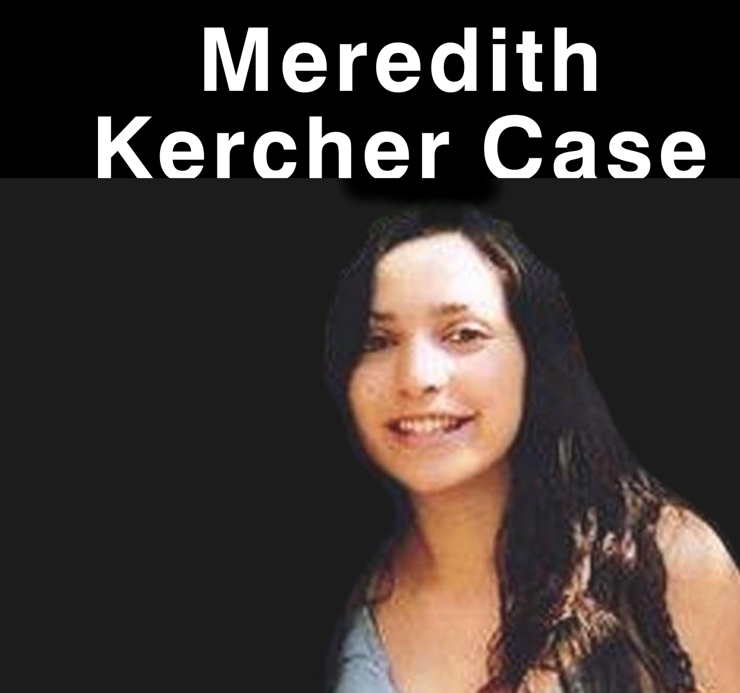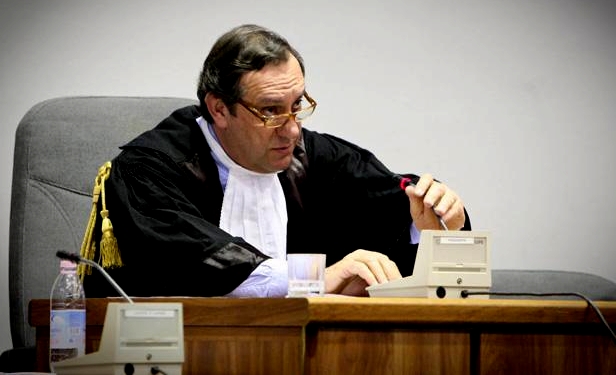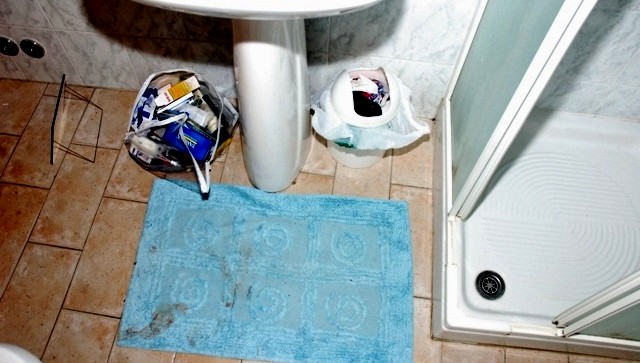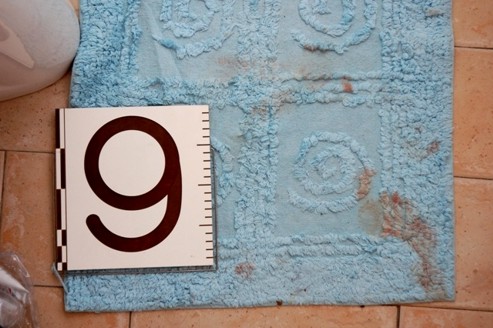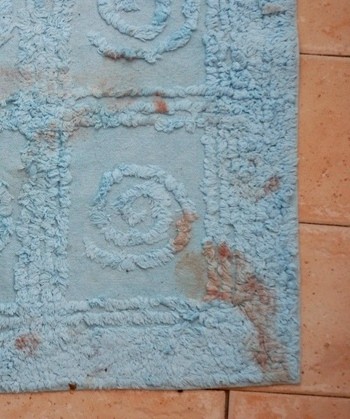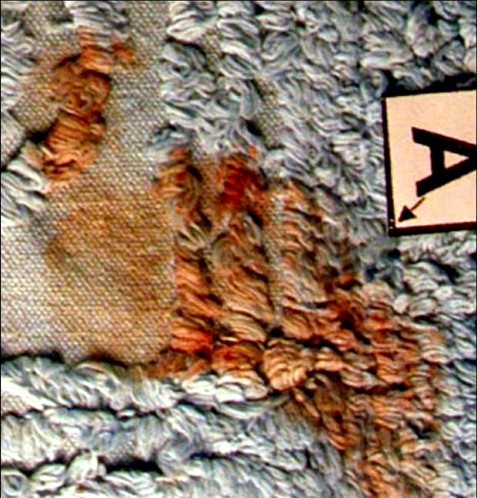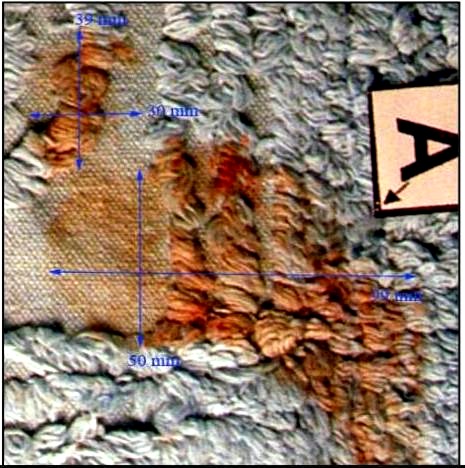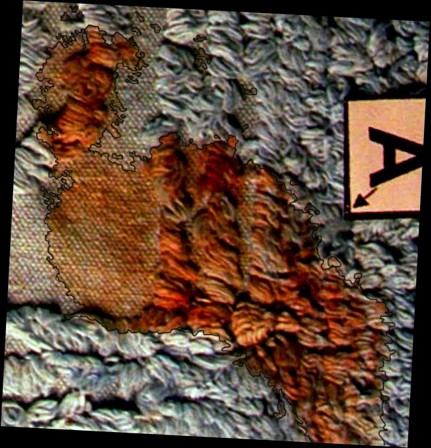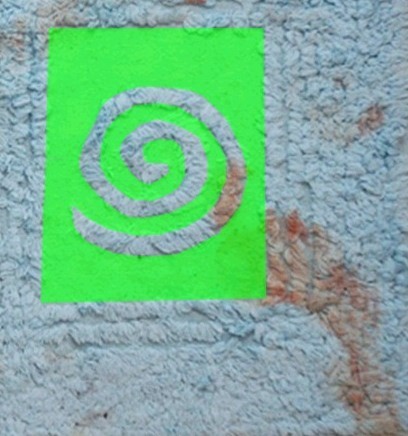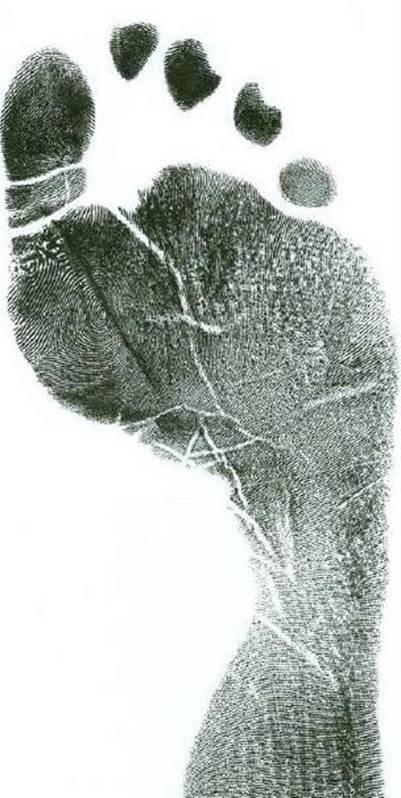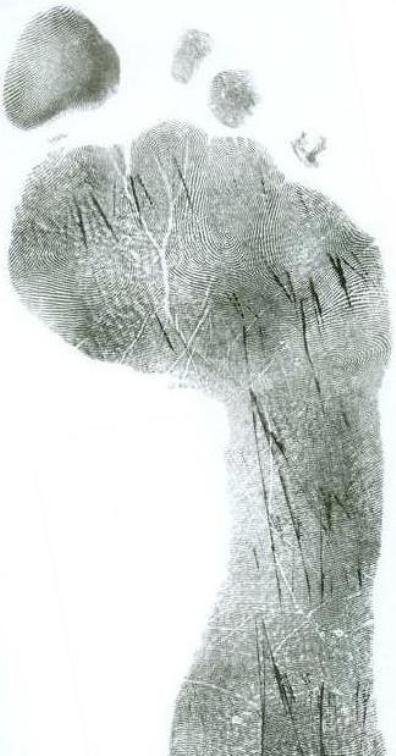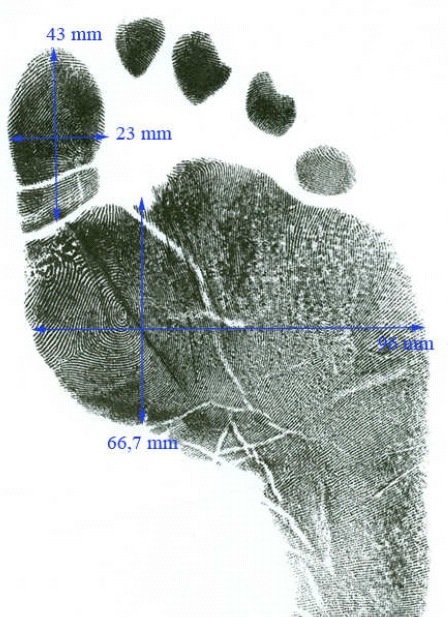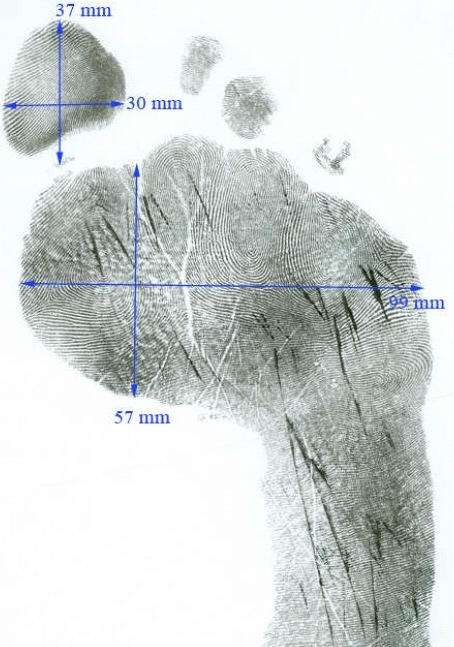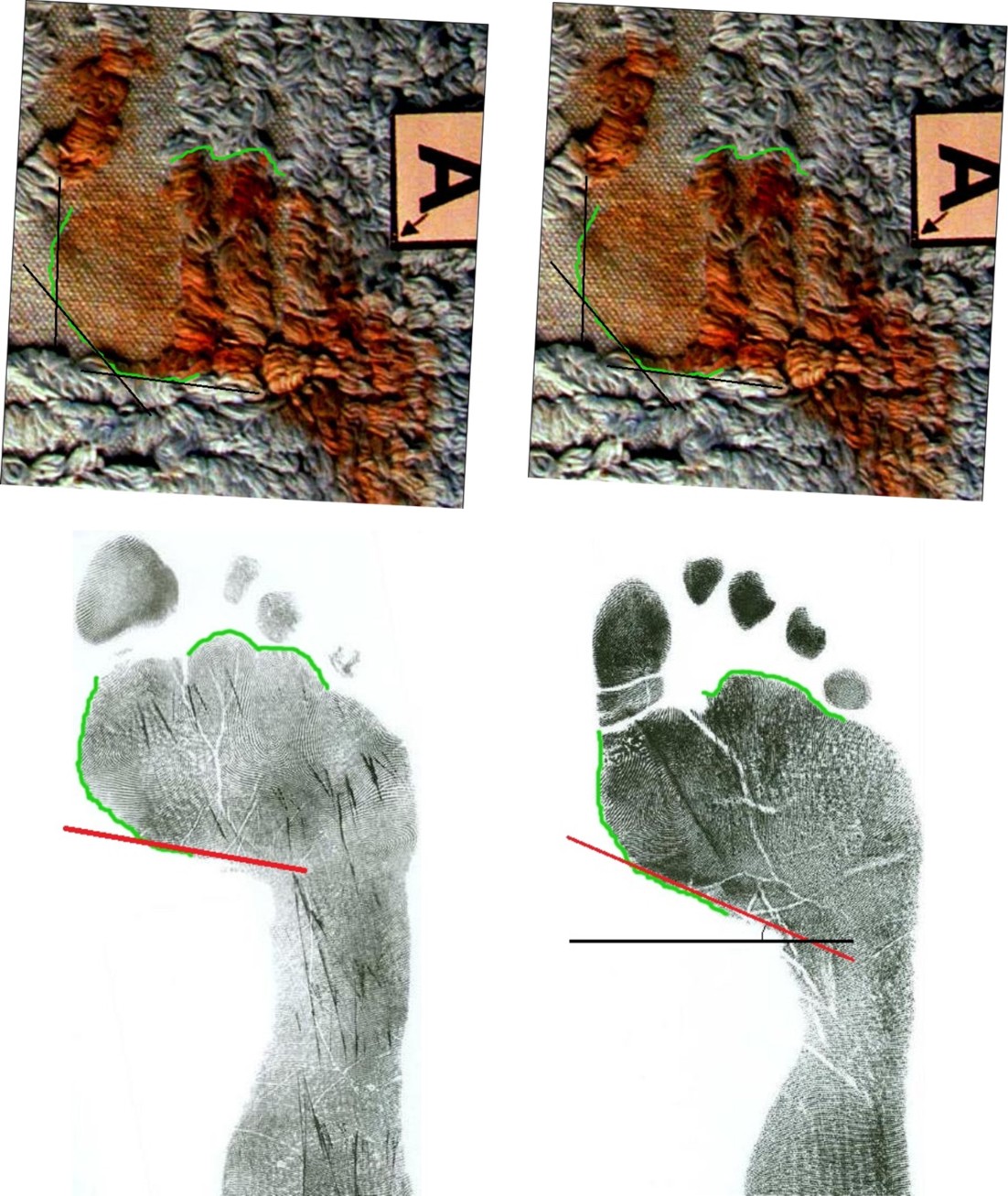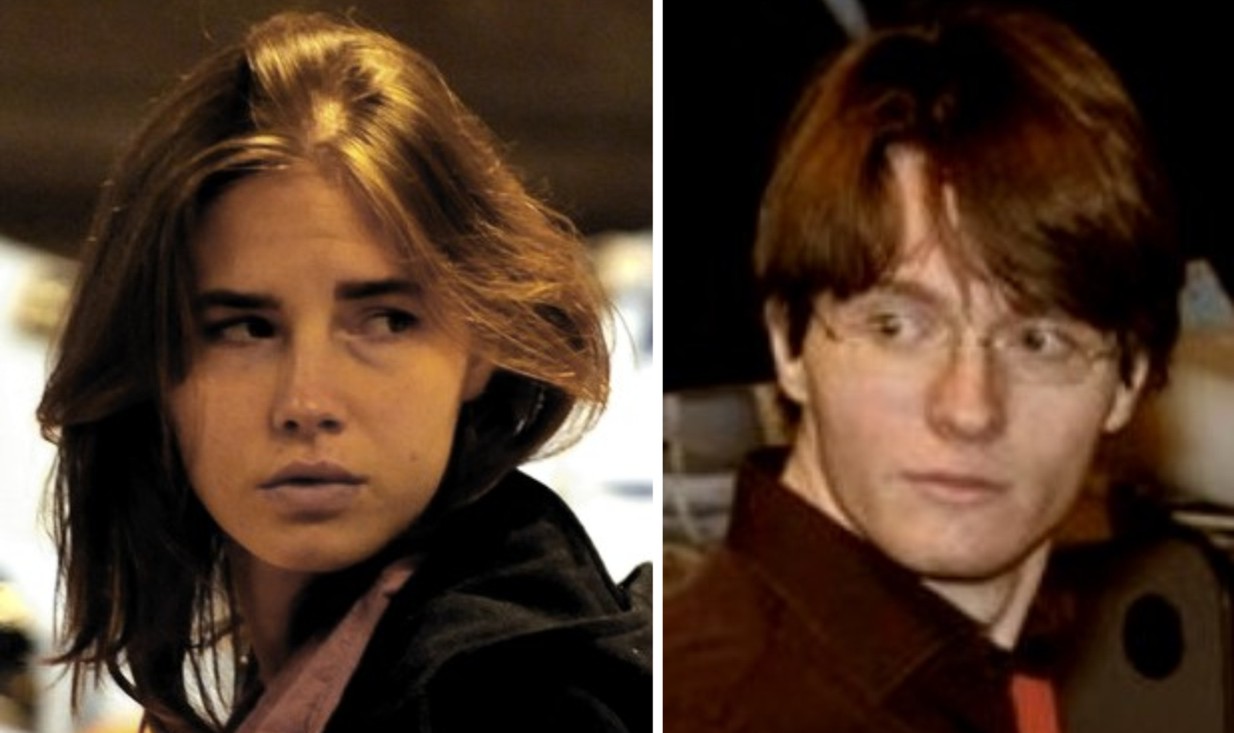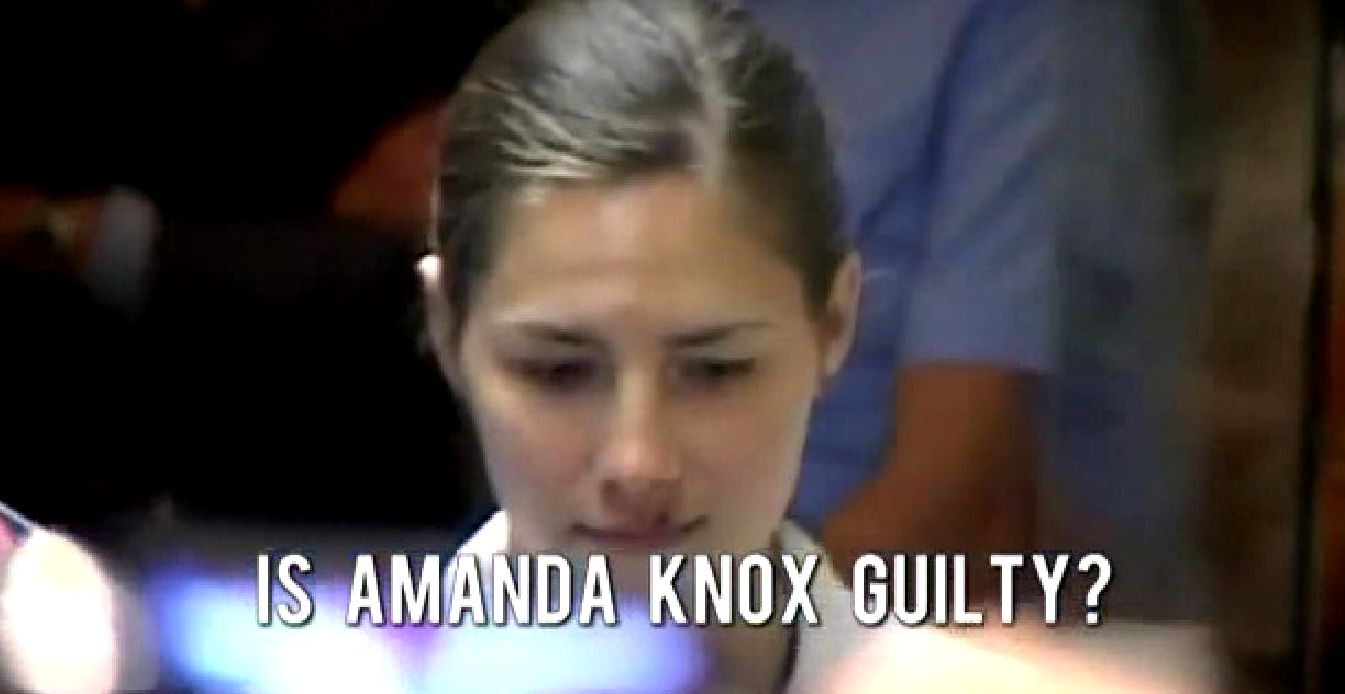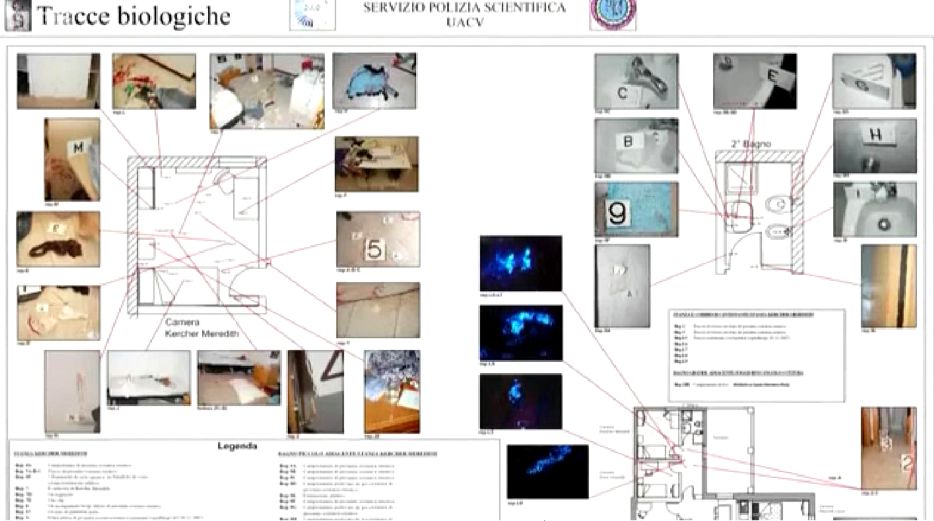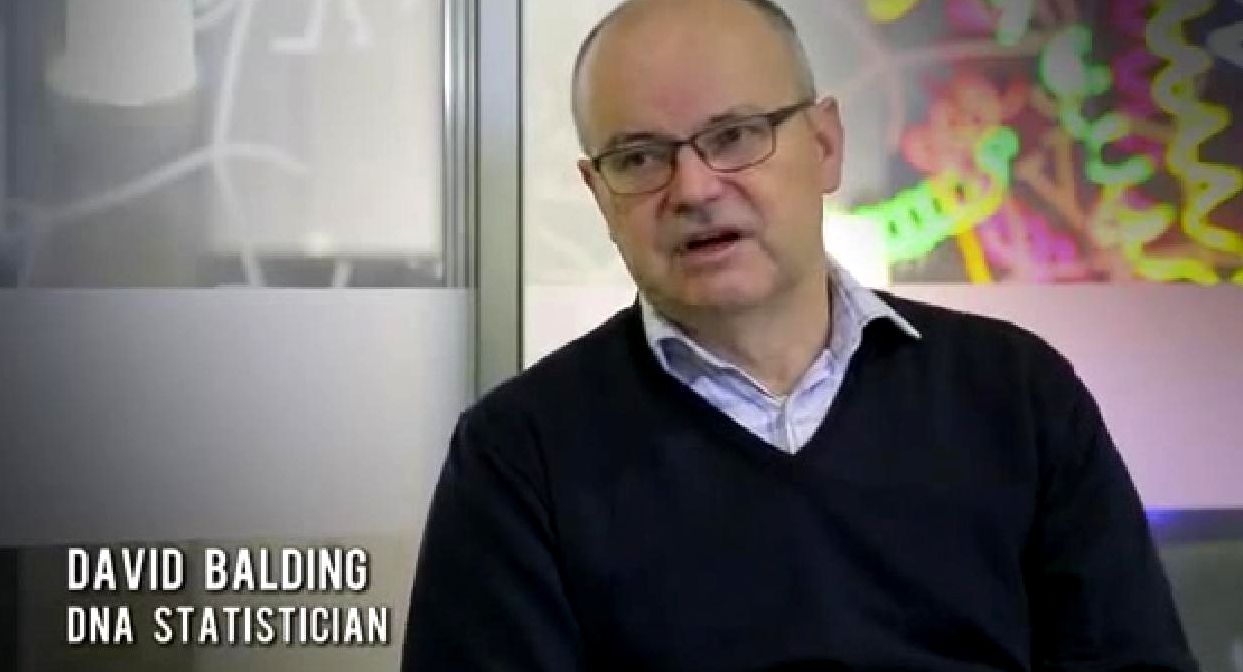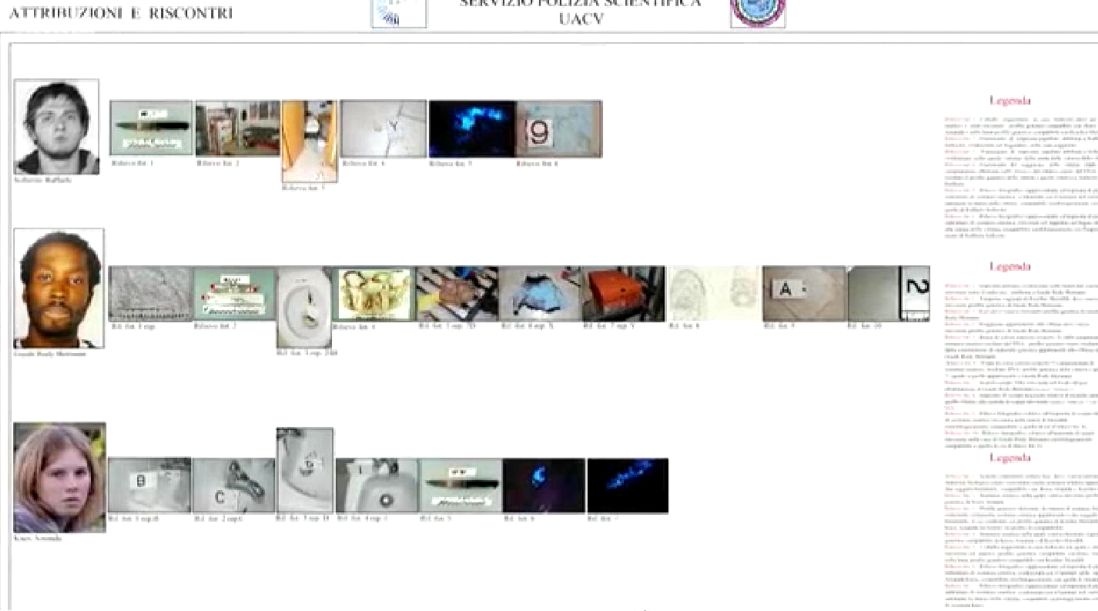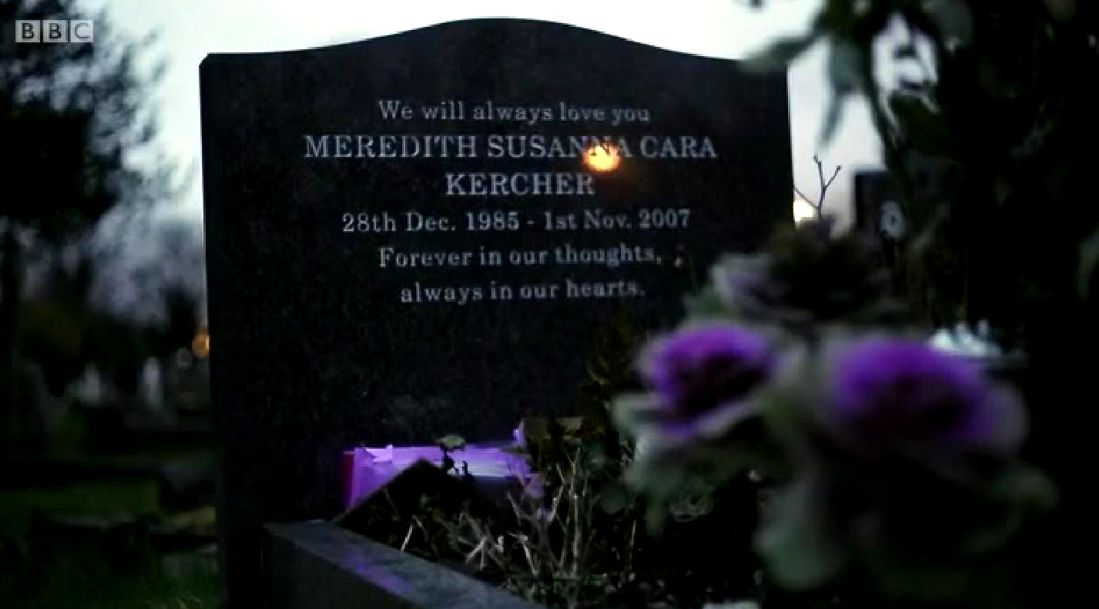
Headsup: The deep expose with associated comments below was first posted by Finn MacCool on 12/20/13. Knox's failed calunnia trial in 2009, failed 1st appeal in 2011, and failed final appeal in 2013 had come and gone. Some 500 zombie misrepresentations had recently reappeared in Knox's English-only 2013 book. See main support documents here and also (vitally) this and this and this.
Category: Hoaxes re Guede
Monday, September 15, 2014
Analysis #1 Of Testimony Of Marco Chiacchiera, Director, Organized Crime Section, Flying Squad
Posted by Cardiol MD
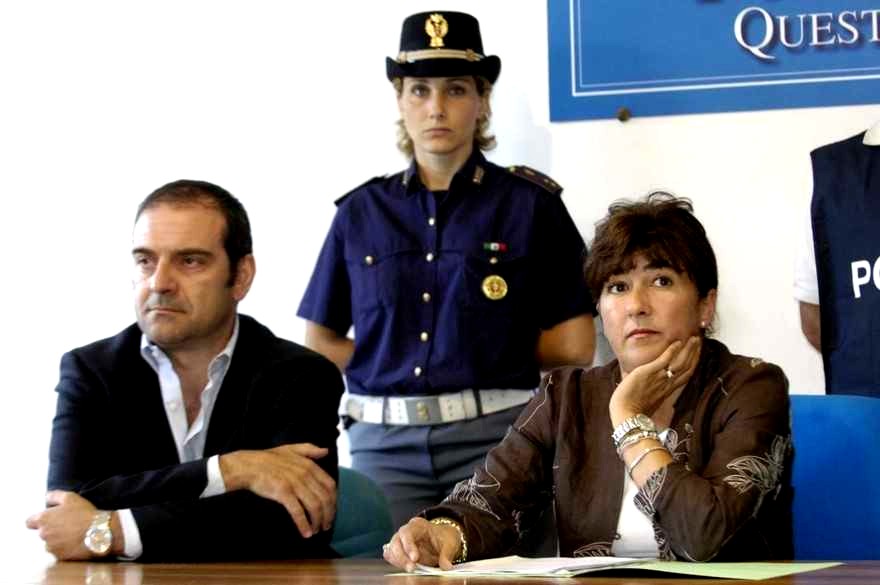
Dr Chiacchiera with Dr Comodi explaining reason for charges in another case
Overview Of This Series
Yet another vital translation which will be posted in the trial testimony areaof McCall’s great Wiki. This again is translated by the ever-dedicated main posterr ZiaK.
Although I graduated as a medical doctor I also graduated as a lawyer, and was often in courtrooms. For this post and the rest of the Chiacchiera series I am wearing my lawyer’s hat to point out what strikes me in Prosecutor Comodi’s questions, Marco Chiacchiera’s testimony, and the cross-examinations by defense lawyers.
Prior Preparations And Procedures
Under the Italian Code, before the beginning of the trial phase in Italy, the parties file a brief, detailing all evidence they want to present ““ the parties have to indicate by name every witness and precisely what these will be asked. The aims include creation of a Record of Admissible Facts.
Also under the Italian Code, both the defendant and the prosecutor can cross-examine each other’s witnesses. The Judge may choose not to admit any testimony that appears patently superfluous, reject irrelevant or improper or irregular questions ““ such as leading questions, and Inadmissible Hearsay ““ and also ask questions to the witnesses and experts.
Ground Covered In Dr Chiacchiera’s Testimony
- (1) He found Knox and Sollecito uncooperative when he asked them questions.
(2) Saw evidence contradicting any lone burglar theory and indicating that the “break-In” to Romanelli’s room was faked.
(3) Phone records and the police investigation into the accused phone activity the night of the murder.
(4) Discovery of pornographic magazines at Sollecito’s house.
(5) Details of how the large knife, Exhibit 36, was collected from Sollecito’s and the evidence that it is the murder knife.
My Assessment Of This Court Exchange
It is immediately obvious to me that this witness is a skilled witness; as such, and given his deep hands-on involvement in the immediate investigation this witness’s testimony is credible. My assessment therefore is that this was a very good and unflinching witness and that Dr Comodi shows no signs of leading the witness or seeking other than a truthful record.
I have seen prosecutors examine witnesses differently but dont believe the resultant record would have been superior. This would have stood up well in any American court.
(GCM=Giancarlo Massei; MC=Manuela Comodi; MaCh=Marco Chiacchiera; GB=Giulia Bongiorno; DD=Donatella Donati; CP=Carlo Pacelli; LG=Luciano Ghirga; CDV=Carlo Dalla Vedova; FM=Francesco Maresca)
Public Prosecutor Comodi [MC]
MC: Dr Chiacchiera, you carried out your duties where, when, at what moment of the events?
MaCh: I was and am the director of the Organized Crime Section of the Flying Squad and I am the vice-director of the Flying Squad. The Organized Crime Section is a branch of the Flying Squad that deals with “¦ the term, I think that in this place [i.e. the court] it is enough to say that it deals with organized crime. However, I am also the vice-director of the Flying Squad, for which [reason] I deal with, in the case of need, everything that is necessary [for] the various aspects.
{Witness supplies 5 items of relevant information that Examiner should elicit at beginning of examination.}
MC: Can you tell the Court how you became aware of events, who called you, when you became involved?
{Examiner asks another triple-question}
MaCh: Yes.
{Witness simply answers question as worded by Examiner}
MC: For now, start to tell us, then maybe I will intervene [NdT: i.e. interrupt with further questions] if necessary.
{Examiner, asking no Q, instructs witness, suggesting provisional forbearance if witness does not make interruptions necessary.}
MaCh: On the fateful day, at around 12:33, I had gone to the cemetery with my mother. The operations room called me immediately after the discovery of the body.
{Witness begins appropriate narrative response, but Examiner interrupts}
MC: So the 113? [NdT: 113 is the Italian State Police emergency number]
{Examiner interrupts witness with a Q, suggesting witness's receipt of call from an emergency number, but suggests wrong source-number}
MaCh: 110. The operations room of the Questura called me, and informed me of the happenings in an initially obviously very summarized manner. They said to me that there was a suspicious death, a young woman who lived in via della Pergola. I rushed to the place directly in my mother’s car. I didn’t stop by at the Questura, I didn’t go to get the service [i.e. police] car. I got myself taken to via della Pergola. We took about 15 minutes from the cemetery to there, ten fifteen minutes. In the meantime, I phoned the deputy Commissioner Napoleoni, in the temporary absence of the director, Dr Profazio, who arrived later, who was “¦ he was enjoying a period of leave, and with deputy Commissioner Napoleoni we arrived almost at the same time. We arrived almost simultaneously at the premises. Forensics, too, arrived almost at the same time at the premises.
{Witness supplies correct source-number and resumes interrupted narrative response}
MC: The Perugia Forensics?
{Examiner questions witness's correction, as if to verify and to ensure accuracy of court's record}
MaCh: The Perugia Forensics, I highlight, yes.
{Witness emphatically agrees with Examiner's question}
MC:”‹[They were] alerted by you, or ...?
{Examiner pauses mid-Q, inviting witness to guess complete Q, or is interrupted}
MaCh:”‹Alerted by the operations room, and also alerted by me.
,
{Witness responds to invitation, or interrupts with A to assumed complete Q}
MC:”‹So you arrive, and who do you find?
{Examiner's 1st simple Q.}
MaCh: “‹I found there ... there was already deputy Commissioner Napoleoni, there were also a few of Meredith’s co-tenants. There was Amanda Knox, there was Raffaele Sollecito. There were two young men who were, I believe, the friend of the boyfriend of one of the co-tenants. In short, there were a few people who had already been inside the house. There was the Postal Police.
{Witness answers Q in reasonable detail}
MC:”‹In the person of”¦?
{Examiner seeks more detail re specific Postal Police Personnel}
MaCh: “‹Battistelli and another of Battistelli’s colleagues. Inspector Battistelli, with whom there was immediately a discussion in order to understand what were the reasons for his intervention there, because it is not normal to find the Postal [police] in a crime of this sort. And he explained to me immediately what was the reason for his intervention. The origin of the, shall we way of his intervention, was due to the discovery of a pair of cellphones in a period of time, I believe, of an hour, [or] two, I don’t recall clearly, that were one in the name of one of Meredith’s co-tenants and one in the name of, later it [sic] “¦ I mean the SIM [card], obviously, the cellphones’ SIMs, the cards, they were in the name of a co-tenant and the other in Meredith’s [name]. The co-tenant, however, then told us, we then ascertained that both of the cellphones in fact were used by Meredith. And already that was, how shall we say, a first detail on which we began to reflect because, in fact, that was an element than in some way made us [become] immediately occupied/involved from an investigative point of view.
{Witness responds to Q and includes relevant amplifying narrative, anticipating probable future Qs re cellphones}
MC: “‹So, excuse me, also if the Court already, shall we say, knows this, because others have reported it, on this point however, where were the cellphones found?
{Examiner seems to interrupt with simple Q to clarify specific relevant fact not yet reached}
MaCh:”‹Inside the garden of a villa that is in via Sperandio.
{Witness responds appropriately}
MC:”‹In via Sperandio.
{Probably a Q, but implicitly inviting more specificity}
MaCh: “‹A villa that ... I am Perugian, [and] honestly, I didn’t even know there was a villa there. I’m Perugian, and I swear that I would have sworn [sic] that behind there was a wood.
{Witness flounders, seems unable to be more specific}
MC:”‹A field
{Probably a Q, but implicitly inviting more specificity}
MaCh: “‹It [was] the first time that I went in behind there. Instead, I see a marvelous old mansion with an enormous garden that gives ... that is almost adjacent to the street ““ the street that leads towards Ponte Rio. Anyone from Perugia understands me maybe.
{Witness seems to be in informal conversational mode}
MC: “‹From the structure of the fencing/enclosure, could you tell, shall we say, whether it was possible to throw these cellphones from the street, or whether it was necessary to enter the garden itself?
{Examiner engages witness, and asks Q to clarify how cellphones got into that garden}
MaCh: “‹Yes, obviously, we checked that. In fact, immediately, in short, the detail that seemed, how shall we say, of great investigative interest was that [very point], besides other details that I will go [into] a bit [sic], so to speak, also to give the impression of what the immediate impact was that we saw in the moment when we found ourselves in a situation of this type. So, deputy Napoleoni immediately entered inside the house in order to check it for herself. I did it [entered] shortly afterwards, also because [as] you will imagine that in that moment whoever was there had to notify all those who [sic], amongst whom Dr Mignini who was the Public Prosecutor on duty, and immediately give orders so that the correct checks are carried out. Because it was not just a crime scene that had to be analysed immediately: there also had to be, how shall we say, correlated with the information that we had got from via Sperandio ““ because the entry of the Postal [police in the case] originated with via Sperandio. And so we immediately asked ourselves: “Ah, what are these cellphones belonging to poor Meredith doing inside the garden of a villa?” And then And then immediately after, we asked ourselves, obviously, what might be the profile of the possible, or probable, murderer, and we discussed/talked about the crime scene. The crime scene immediately seemed fairly strange to us, if you wish [NdT: literally “if we wish” in Italian, but meaning the same as “shall we say”, “if you wish”, “so to speak” etc.]
{Witness responds to Q with detailed narrative}
MC:”‹Why?
{Examiner asks ambiguous Q, probably wrt crime scene seeming "fairly strange "}
MaCh:”‹Because the door did not show”¦ the entry door to the villa did not show signs of break-in. The we checked “¦
{Witness seems to decipher ambiguity correctly, begins narrative response, but is interrupted by Examiner}
MC:”‹We are not talking about the villa on via Sperandio obviously?
{Examiner interrupts with Q, apparently not comprehending Witness's narratives}
MaCh: “‹For the love of god! It was called a “villa” “¦ (overlap of voices), let’s say the house, of the house on via della Pergola there was no forcing/break-in. We found a forcing on the window. The window is this one, on the side of the house. I don’t know if you’ve seen the house? Anyhow, it is this one on the side of the house that can be seen immediately when you come down the slope from the gate. Logically reconstructing the thing, a hypothetical prowler [NdT: literally “ill-intentioned person”] who entered the house, breaking the glass with a rock - because inside the room, which was Romanelli’s room, which was the, shall we say, hypothetical arena of the entry, was completely in utter chaos. For that reason, what should we have hypothesized? That the hypothetical prowler took a rock, managed to throw the rock; the shutters, the external ones, the external shutters were not “¦
{Witness is exasperated at Examiner's apparent incomprehension, is repeating his previous testimony, but is interrupted by Examiner}
MC:”‹The dark-green wooden ones?
{Examiner interrupts with Leading Q re colour of external shutters. Now begins a confused and confusing colloquy. The arrangement of Filomena Romanelli's window, with Outside, and Inside Shutters, the Broken-Glass-Frame in-between, and the glass-splinters on the window-sill is complicated and needs a picture-exhibit that the witness can refer-to; this is apparently not provided, leading to the confusions}
MaCh:”‹The dark-green wooden ones were half shut, for which reason [he] must have had an aim like “Pecos Bill” [NdT: a cartoon Wild West cowboy], takes aim and throws that rock, smashes the window. After, he climbs up and does a turn on the little slope, and has to clamber up towards the window on the smooth surface, it seems to me, that from the ground up to the window there are two and a half metres-three [metres]. And then would have said: “bah, in short” [sic]. Yeah, well, the thing seemed to us…. in short, the first hypothesis that the investigator normally does, finds a level of unlikelihood of this kind of happening. After which, we looked at the house and we saw that an entry of a potential prowler [ill-intentioned person], still reasoning on the hypothesis”¦
{Witness amplifies narrative response but is interrupted by Examiner}
MC:”‹Of theft.
{Examiner inappropriately interrupts, incorrectly guessing what witness was about to say}
MaCh: “‹Of theft ending badly. Of theft that then degenerates because the burglar in some way thinks that he will find no-one in the house and instead finds a person, and then it degenerates “¦ We saw that there were easier means of entry, without wishing to bore you, but behind the house there was the possibility of climbing in a much easier way, without being seen by people that might have passed in the road. Let’s remember that, in short, it was not very late; quite the contrary. Normally people passed there, for which reason, if [he] had done it, the thing would probably have been seen. That thing there, as an hypothesis, we didn’t immediately discount it, that’s clear, because it’s a good rule to never discount any hypothesis. But we immediately considered that it was not a priority.
{Witness corrects Examiner's wrong guess, amplifies and seems to end narrative response}
MC:”‹Dr Chiacchiera, I interrupt you. (The witness is shown an exhibit.)
{Examiner, seems to acknowledge her habit of interruptions without actually interrupting, while introducing an unspecified exhibit. This introduction seems very informal, because Exhibits are normally identified by an assigned title.}
MaCh:”‹Ah! I didn’t remember it as being so big.
{Witness recognizes unspecified exhibit}
MC:”‹Precisely! You saw it? This is the rock that ...
{Examiner engages witness, stating it is "the rock".}
MaCh:”‹Yes, but it has been some time I have not, how shall we say, yes, I saw it. Absolutely.
However, it’s big, it’s huge.
{Witness engages Examiner, commenting on how large the rock exhibit is}
MC:”‹Do you consider that it could be this?
{Examiner ambiguously (what are "it" & "this "?) asks witness's opinion}
MaCh:”‹I believe so.
{Witness seems to overlook ambiguity of Q with vague A)
MC:"‹I try "¦
{Examiner begins to speak but is interrupted}
Judge Massei [GCM]:”‹How?
{Court interrupts as if to ask Q how Examiner 'tries'}
MC:”‹It is this. Yes, it is this one that was collected, yes, that was found.
{Witness seems to confirm that exhibited rock is the rock found in Filomena's room}
GCM:”‹So the rock is shown. [NdT: an “aside” for the court records?]
{Court formally announces admission of rock-exhibit, seemingly trying to reduce confusion caused by informal dialogue}
MaCh:”‹Inside the room where we then found the rock…
??:”‹But what was the question about the rock?
{Witness amplifies that rock had been found in a room, but enquires re rock Q, exposing confusion caused by informal dialogue}
GCM:”‹If this was the rock. And the witness said ...
{Court begins explanation to confused witness}
MaCh:”‹I said yes. Yes.
{Witness interrupts Court - confusion reigns}
GCM:”‹You saw it? You saw the rock?
{Court asks witness 2 Qs, trying to clarify that 'it' refers to 'the rock' that witness saw.}
MaCh:”‹Yes.
{Witness confirms that witness had previously seen the rock introduced into court as an unlisted exhibit.}
GCM:”‹When you saw it, where was it?
{Court proceeds to clarify confusion re where the rock was when witness originally saw the rock}
MaCh:”‹The rock [was] in the room of Romanelli.
{Witness specifically testifies, for witness's first time, that when witness originally saw the rock, the rock was in Filomena Romanelli's room}
GCM:”‹How far from the window? Can you say?
{Court continues to seek clarification using double-Q.}
MaCh: “‹A few centimetres [NdT: “un palmo” = “a hand’s width”] from the window sill, under the window, from the wall where the window is.
{Witness testifies clearly in answer to Court's 1st Q of above double-Q.}
GCM:”‹So from the internal perimeter wall, from where the window gives onto it, a “hand’s breadth”. So 20 centimetres…
{Court apparently begins to seek verification of witness's testimony, but is interrupted}
MaCh:”‹Mr President ....
{Witness begins to Interrupt Court}
GCM:”‹... away from it approximately.
{Court finishes his interrupted statement}
MaCh:”‹Yes.
{Witness agrees with Court's completed statement}
GCM:”‹And this is the rock. You remember it.
{Court states his understanding in form of Qs.}
MaCh:”‹Yes, yes, yes, yes. That is the rock.
{Witness impatiently agrees with Court's understanding}
MC:”‹At least as far as size and colour [are concerned], it corresponds thus to the one that was collected [as evidence].
{Examiner makes statements in form of Q, seeking verification of resemblance of exhibit-rock to original rock}
MaCh:”‹At least as far as size and colour [are concerned], it absolutely corresponds. If it was collected, I think that ...
{Witness begins narrative agreement with statements of Examiner, but is apparently interrupted by Examiner}
MC: “‹Very well. WITNESS [sic? Should be MaCh?] and Romanelli’s room was a complete shambles. The clothes were on the floor, the glass was strangely on top of the clothes, the [glass] shards were strangely on top of the “¦ on the windowsill, let’s put it that way.
{Apparent Transcriptional confusion attributing to interrupted witness narrative the interrupting .statement of Examiner}
MC:”‹The outside one.
{Examiner seems to amplify statement of Examiner wrt which window-shutter witness had been referring-to}
MaCh: “‹The outside one, precisely. The one that is between the shutters and the shutters [sic. NdT: “imposte” in Italian, but this can also mean shutters, or flap, as in the inner “scuri” shutters, or he may mean the window-frame itself, with the window-panes, given his following description], the green shutters and the shutters, the broken ones in short, where the glass is. The shutters ““ the wooden ones. The rock was a bit too close with regard to the wall if I [were to] throw it from least two metres. Unless it was lobbed [i.e. thrown in a high arc]. But in that case it’s rather unlikely that it would smash the glass. For that reason, I repeat, in the context of immediate likelihood, this one “¦
{Witness agrees with Examiner that he was referring to "The outside one", continuing with narrative of reasoning, but is interrupted by Examiner…}
MC:”‹Yes, it’s true. These are considerations. However they are considerations, shall we say, that refer [sic], because they are reasoning/lines of thought that are formed in the “immediacy” of the events [NdT: i.e. “in the immediate aftermath”. NOTE: throughout the text, a number of speakers use “immediatezza” (lit. “immediacy”) to convey a number of meanings, from “in the immediate aftermath”, or “in the immediate surroundings”, or “very soon after”, etc. I will translate them appropriately according to the context, without further explanation of the use of “immediatezza”], in order to proceed in one direction rather than another.
{Examiner, interrupting witness, apparently agreeing with witness's reasoning. While Examiner is apparently stating his own argumentative reservations re the possible evolution-in-time of witness's changing lines of reasoning, he is interrupted by Giulia Bongiorno, Sollecito defense lawyer:}
Giulia Bongiorno [GB]: “‹I never like to interrupt an examination [of a witness], however if one wanted, between the Public Prosecutor’s hypotheses, to do that [sic] of demonstrating that from a ballistic point of view it is not possible, then the ballistic expert should be called.
{GB interrupts Examiner to comment that Witness and Examiner are expressing opinions on Ballistics that require the testimony of a Ballistic Expert.}
MC:”‹But in fact, his considerations are not the considerations of an expert: they are the considerations of an investigator who made certain deductions in the immediacy of the events.
{Examiner argues that witness's testimony is that of an investigator's temporal train of thought.}
MaCh:”‹It happens to us too, at times, to reason/think rationally “¦
{Witness joins colloquy, amplifying Examiner's argument.}
GCM:”‹These reasonings/deductions, then determined your investigative activity in one direction rather than in an “¦?
{Court seems to invite further amplification by witness}
MaCh: “‹Yes, obviously, Mr President. I was trying to ... (overlap of voices) it is a premiss/basis to be able to then, how shall we say, reach ““ I won’t say conclusions ““ but in order to try to understand what our way of broaching the thing was, there and then. We had, I reassert, reasoned immediately also on via Sperandio. So the first thing, I may say, [was] the unlikelihood, or at any rate it was not the top priority hypothesis, the one of a prowler/ill-intentioned person entering. The open door without signs of break-in. But above all, a young woman who is [sic] probably killed in her own room, nude or almost nude, with a wound of that type, in a lake of blood, covered with a duvet. I repeat, the door was not smashed/wrecked, there’s a broken “¦ a window broken with a thrown rock, how can I say, it’s obvious that we immediately found this situation as “¦ (overlap of voices).
MaCh:”‹”¦ particular.
{Witness further amplifies narrative}
GCM:”‹You formed these considerations, and what did they lead you to?
{Court asks simple Q.}
MaCh: “‹That very probably the author or authors knew the person, or at any rate that the author or authors did not enter “¦ did not enter from the window-pane of that window.
{Witness responds with his conclusion that the authors of the faked break-in did not enter from the window-pane of that window.}
GCM: “‹Excuse me a moment, just to give some guidelines, but of the evaluations that the witness is expressing, obviously it’s not that they can be taken account of, however we will acquire them [for the trial files] in order to understand the investigation activities, the appropriateness of the investigations that were carried out, directed in one way or in another, there you go. However, maybe, “¦ there you go, yes, maybe if we can manage to keep with the bare essentials this will help everybody.
{Court proceedings seem to have been diverted into a free-for-all colloquy, with multiple participants chiming-in, and creating confusion. Court-President, GCM, now politely intervenes, apparently trying to restore order, ruling that the professional evaluations made by the witness, testified-to by the witness, should be admitted for the trial files. The appropriateness of the witness's evaluations can be dealt with separately and later.}
_________________________________________________
This segment of Chiacchiera’s Testimony re the Crime Scene, which he believed had been remodeled by the criminals to dupe Investigators into believing that there had been a burglary, committed by a single criminal, is paused here because it is so prolonged.
Analysis of Chiacchiera’s Testimony will continue in a future post.
Thursday, June 12, 2014
Fifty Of The Most Common Myths Still Promoted Without Restraint By The Knox PR Campaign
Posted by The Machine
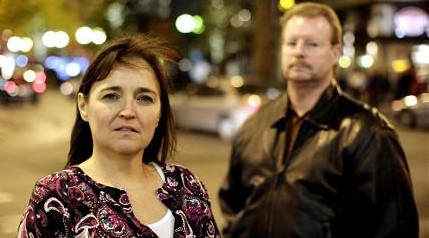
Fooled ya! Knox’s parents have the mythmaking machine’s pedal to the floor, and arent slowing it
Introduction
I’ve listed the 50 most common myths circulating in the media with regard to the Amanda Knox/Meredith Kercher case and refuted them using as far as possible the official court documents and court testimony.
1. Knox was called to the Perugia central police station on 5 November 2007.
Neither the police nor the prosecutors brought Knox in for questioning on 5 November 2007. She was there unwanted, and stayed after it was suggested she go home and sleep.
Amanda Knox herself testified in court that she wasn’t called to come to the police station on 5 November 2007.
Carlo Pacelli: “For what reason did you go to the Questura on November 5? Were you called?”
Amanda Knox: “No, I wasn’t called. I went with Raffaele because I didn’t want to be alone.”
Monica Napoleoni, the head of Perugia’s homicide squad, said they told Knox she should go home to rest, but Knox insisted on staying:
Amanda also came that evening, the evening of the 5th. We said to Amanda that she could go home to rest. Since, during those days, she was always saying, always complaining that she wanted to rest, wanted to eat, we said: “˜Look, you’ve eaten; you can go and rest yourself. If there’s a need, we’ll call you.’
Instead, she was very nervous, and insisted on staying there.
Inspector Rita Ficarra was the one who led the discussion on a list of possible perps with Knox.
Rita Ficarra: My astonishment was that I saw, I found her there, and I found her doing ““ demonstrating ““ her gymnastic abilities: she was doing a cartwheel; she had shown the back arch, she had done the splits, and it seemed to me, sincerely, a bit out of place, that is to say given the circumstances, the moment and the place. For which [reason] I admonished her, and I even asked her what she was doing there.
She, and my colleagues also confirmed this, said to me that she had come because they had called Raffaele Sollecito, he had been invited that evening to give another recap, and she had accompanied him.
Judge Massei [GCM]: You said this to her in English or in Italian?
RF: In Italian. I reiterate that she speaks Italian, with me she speaks only in Italian. I do not understand a word of English, so “¦ My colleagues confirm that there was Sollecito who was there in another room and in that moment the Deputy Commissioner Napoleoni and other colleagues were listening to him.
And continuing to speak, the girl told me that she was rather shocked at the fact, annoyed at the fact that she had been called and recalled several times by the Police and [that] she was totally tired.
At that point, I also admonished her because I said: you’re tired, yet nonetheless you came this evening, when nobody has invited you: you could have gone to rest. And furthermore ““ I said ““ you don’t understand that we are talking about a murder, of a person that you say was your friend, [who] lived in the same house as you, it happened in your house. If the Police call you, put yourself in our shoes: we need useful information.
2. Knox was subjected to an all-night interrogation on 5/6 November.
According to Barbie Nadeau in The Daily Beast, Amanda Knox’s questioning began at about 11:00pm.
“Since Knox was already at the police station [in the company of Raffaele Sollecito], the head of the murder squad decided to ask her a few questions. Her interrogation started at about 11pm.”
After Amanda Knox had made her witness statement at 1:45am, she wasn’t questioned again that evening. She decided to made another witness statement at 5:45am, but she wasn’t asked any questions.
3. Knox wasn’t provided with an interpreter for her questioning on 5 November 2007.
This claim is completely false as shown through the trial testimony of Knox and her interpreter. Knox’s interpreter on 5 November 2007, Anna Donnino, testified at length at trial about Knox’s convesrsation that evening. And Amanda Knox herself spoke about her interpreter when she later gave testimony at the trial.
4. Knox wasn’t given anything to eat or drink.
Reported by Richard Owen, in The Times, 1 March 2009:
Ms Napoleoni told the court that while she was at the police station Ms Knox had been “˜treated very well. She was given water, chamomile tea and breakfast. She was given cakes from a vending machine and then taken to the canteen at the police station for something to eat.’
Also reported by Richard Owen, in The Times, 15 March 2009:
Ms Donnino said that Ms Knox had been “˜comforted’ by police, given food and drink, and had at no stage been hit or threatened.
John Follain in his book Death in Perugia, page 134, also reports that Knox was given food and drink during her questioning:
During the questioning, detectives repeatedly went to fetch her a snack, water, and hot drinks, including chamomile tea.
This is from the relevant court transcript:
Monica Napoleoni: Amanda was given something to drink several times. She was brought hot chamomile; she was taken to the bar of the Questura to eat. First she was given brioches from the little [vending] machine.
Carlo Pacelli: These methods of treatment, how did they translate into practice? With what behaviour/actions [were they carried out] in actual fact? Earlier, you recalled that they actually brought her something to eat”¦
MN: It’s true. That morning, I remember that Inspector Ficarra actually took her to the bar to eat as soon as it opened. But before [that], we have little [vending] machines on the ground floor, and she was brought water, she was brought hot drinks, she was brought a snack. But also Raffaele, he was given something to drink; it’s not as though they were kept “¦ absolutely.
Giuliano Mignini: Had types of comfort been offered to her?
Anna Donnino: Well, during the evening, yes, in the sense that I remember that someone went down to the ground floor; it was the middle of the night, so in the station at that hour there are those automatic distributors; there’s nothing else; someone went to the ground floor and brought everybody something to drink, some hot drinks and something to eat. I myself had a coffee, so I believe that she also had something.
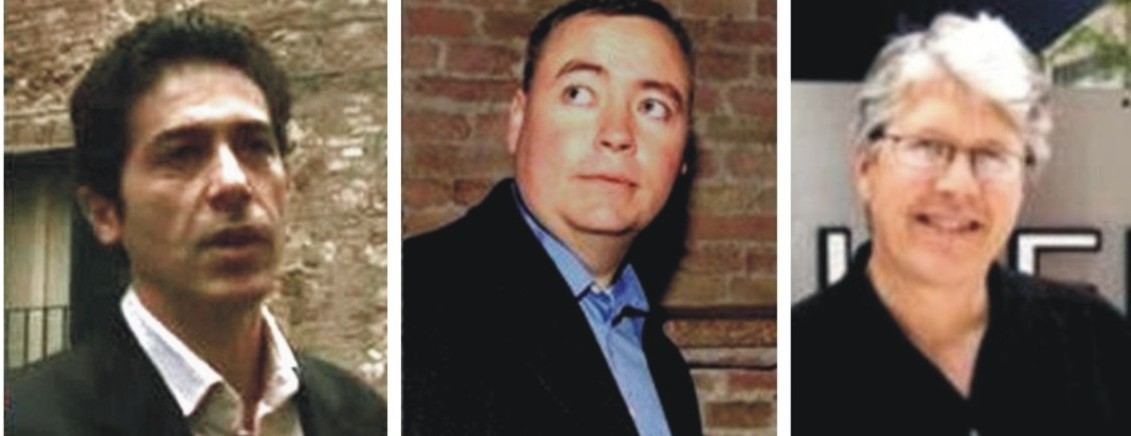
Above: Several of the myth inventors and disseminators: Sforza, Mellas, Preston
5. Knox was beaten by the police.
The witnesses who were present when Knox was questioned, including her interpreter, testified under oath at the trial in 2009 that she wasn’t hit. (Under Italian law, witnesses must testify under oath, while defendants do not, so are not required by law to be truthful on the stand.)
These are from the relevant court transcripts:
Giuliano Mignini: Do you recall, shall we say, that night between the 1st and then the spontaneous declarations and then the order for arrest, who and what was with her, other than you, whether there were other subjects that spoke with us, how they behaved? Did [she] undergo/experience violent [sic: NdT: “violente” in Italian, probably typo for “violenze” = “violence/force/assault”] by any chance?
Rita Ficarra: Absolutely not.
GM: Was she intimidated, threatened?
RF: No. I, as I said earlier, I came in that evening and there were some colleagues from the Rome SCO, I was with Inspector Fausto Passeri, then I saw come out, that is come out from the entry-door to the offices of the Flying [Squad] the Assistant Zugarini and Monica Napoleoni, who appeared for an instant just outside there, then we went back in calmly, because the discussion we had with her was quite calm.
Giuliano Mignini: ... violence, of “¦
Monica Napoleoni: But absolutely not!
Mignini: You remember it”¦ you’ve described it; however, I’ll ask it. Was she threatened? Did she suffer any beatings?
Anna Donnino: Absolutely not.
GM: She suffered maltreatments?
AD: Absolutely not.
Carlo Pacelli: In completing and consolidating in cross-examination the questions by the public prosecutor, I refer to the morning of the 6th of November, to the time when Miss Knox had made her summary information. In that circumstance, Miss Knox was struck on the head with punches and slaps?
Anna Donnino: Absolutely not.
CP: In particular, was she struck on the head by a police woman?
AD: Absolutely not!
CP: Miss Knox was, however, threatened?
AD: No, I can exclude that categorically!
CP: With thirty years of prison”¦ ?
AD: No, no, absolutely not.
CP: Was she, however, sworn at, in the sense that she was told she was a liar?
AD: I was in the room the whole night, and I saw nothing of all this.
CP: So the statements that had been made had been made spontaneously, voluntarily?
AD: Yes.
Carlo Della Valla: This”¦
Giancarlo Massei: Pardon, but let’s ask questions”¦ if you please.
CP: You were also present then during the summary informations made at 5:45?
AD: Yes.
CP: And were they done in the same way and methods as those of 1:45?
AD: I would say yes. Absolutely yes.
CP: To remove any shadow of doubt from this whole matter, as far as the summary information provided at 5:45 Miss Knox was struck on the head with punches and slaps?
AD: No.
CP: In particular, was she struck on the head by a policewoman?
AD: No.
Even Amanda Knox’s lawyer, Luciano Ghirga, distanced himself in the Italian media from these allegations and never lodged any complaint:
There were pressures from the police, but we never said she was hit.
6. Knox was refused a lawyer.
Rita Ficarra and Anna Donnino testified that Knox was several times advised to have a lawyer, but each she declined the offer:
Anna Donnino: ...she was asked if she wanted a lawyer.
Giuliano Mignini: And what was her response?
AD: She had answered no; I remember that she replied with no.
Before she insisted on drafting her 1:45 and 5:45 am accusations Knox was advised to have a lawyer advise her, but she declined and pressed on.
Dr Mignini has wondered if the Supreme Court really understood this in banning the two unprovoked accusations from Knox’s main trial.
7. Knox was tag-teamed by two police officers every hour.
According to Anna Donnino, who arrived at the police station at about 12:30am, there was a total of three people in the room with Knox:
Anna Donnino: “I had been made to enter a room where in fact there was Inspector Ficarra at a small table, another colleague from SCO (I only remember his first name; he was called Ivano), a police officer, and there was Miss Knox seated. I seated myself beside her.”
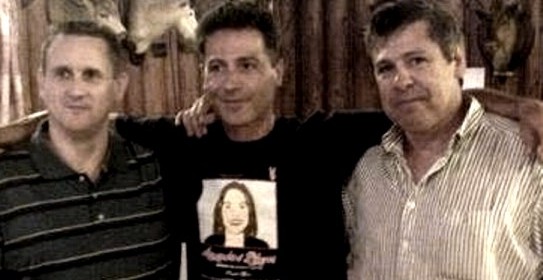
Above: Several of the main myth inventors and disseminators: Fischer, Sforza, Moore
8. Knox was asked to imagine what might have happened.
According to the corroborative testimony of the three others present, including Rita Ficarra and Anna Donnino, Amanda Knox voluntarily and spontaneously accused Patrick Lumumba of murdering Meredith.
Here is Rita Ficarra.
We found only that one [text message] sent by her. She was given the mobile into her hand, and it was said, who is this person, and did you go out later or not? She said the name of Patrick Lumumba, and gave the declaration that then ...
GM: And what behaviour did she then adopt/assume?
RF: She suddenly put her hands to her head, burst out crying and said to us “It’s him, it’s him, it was him, he killed her”. It was the only time that I saw her cry.
GM: This behaviour, did she then continue like that during the course of that morning, by now we were at what time?...
RF: No, she was as if she was giving vent in that moment, she cried, she began to say that he was crazy, he was crazy.
Here is Anna Donnino:
Judge Massei: This change, at what moment did it happen, and in what did it consist of?
Anna Donnono: The change had occurred right after this message, in the sense that the signorina said she hadn’t replied to the message from Patrick, when instead her reply message was shown to her she had a true and proper emotional shock. It’s a thing that has remained very strongly with me because the first thing that she did is that she immediately puts her hands on her ears, making this gesture rolling her head, curving in her shoulders also and saying “It’s him! It’s him! It was him! I can see/hear him or: I know it.[Lo sento]” and so on and so forth.
Carlo Pacelli: So the statements that had been made had been made spontaneously, voluntarily?
Anna Donnino: Yes.
Here is Judge Massei.
[After hearing and weighing up the testimony of these witnesses and Amanda Knox, Judge Massei stated that it couldn’t be claimed that] “Amanda Knox was persuaded by the investigators to accuse Diya Lumumba, aka Patrick, by means of various pressing requests which she could not resist.” (Massei report, page 388.)
[He noted that there had been] “no corroboration of the pressing requests which Amanda was seemingly subjected to in order to accuse Diya Lumumba of the crime committed to the detriment of Meredith.” (Massei report, page 389.)
Judge Massei concluded at trial in 2009 that Knox had freely accused Patrick Lumumba of Meredith’s murder and awarded her a prison sentence for calunnia confirmed in 2013 by the Supreme Court for which there is no further appeal.
9. Amanda Knox claimed she had had a “dream-like vision” in her witness statements.
Amanda Knox makes no mention of a dream or vision in her two witness statements. She categorically states that she met Diya Lumumba at Piazza Grimana and that they went to the cottage on Via della Pergola. In her first witness statement, she claims that Lumumba killed Meredith.
This is from the 1:45 am statement.
I responded to the message by telling him that we would see each other at once; I then left the house, telling my boyfriend that I had to go to work. In view of the fact that during the afternoon I had smoked a joint, I felt confused, since I do not frequently make use of mind-altering substances, nor of heavier substances.
I met Patrik immediately afterward, at the basketball court on Piazza Grimana, and together we went [to my] home. I do not recall whether Meredith was there or arrived afterward. I struggle to remember those moments, but Patrik had sex with Meredith, with whom he was infatuated, but I do not recall whether Meredith had been threatened beforehand. I recall confusedly that he killed her.
This is from the 5:45 am statement.
I wish to relate spontaneously what happened because these events have deeply bothered me and I am really afraid of Patrick… I met him in the evening of November 1st 2007, after sending him a reply message saying “I will see you”. We met soon after at about 21.00 at the basketball court of Piazza Grimana. We went to my apartment in Via della Pergola n. 7.
I do not clearly remember if Meredith was already at home or if she came later, what I can say is that Patrick and Meredith went into Meredith’s room, while I think I stayed in the kitchen. I cannot remember how long they stayed together in the room but I can only say that at a certain point I heard Meredith screaming and as I was scared I plugged up my ears.
10. Amanda Knox was questioned in Italian
The police provided Amanda Knox with an interpreter, Anna Donnino, so that she could be questioned in English.
11. Dr Mignini questioned Knox on 5 November 2007.
Dr Mignini did not question Amanda Knox that evening. She wanted to make further declarations, and he came to the police station on the night only because he was on duty and had to witness Knox being cautioned. After Knox was cautioned that she need not say anything without a lawyer, Knox nevertheless insisted that she draft a second statement in front of him.
Mr Mignini explained what happened in his e-mail letter to Linda Byron, a journalist for King5 in Seattle:
All I did was to apply the Italian law to the proceedings. I really cannot understand any problem.
In the usual way, Knox was first heard by the police as a witness, but when some essential elements of her involvement with the murder surfaced, the police suspended the interview, according to article 63 of the penal-proceedings code.
But Knox then decided to render spontaneous declarations that I took up without any further questioning, which is entirely lawful.
According to article 374 of the penal-proceedings code, suspects must be assisted by a lawyer only during a formal interrogation, and when being notified of alleged crimes and questioned by a prosecutor or judge, not when they intend to render unsolicited declarations.
Since I didn’t do anything other than to apply the Italian law applicable to both matters, I am unable to understand the objections and reservations which you are talking about.”
In Amanda Knox’s written witness statement, she explicitly states that she’s making a spontaneous declaration:
I wish to relate spontaneously what happened because these events have deeply bothered me and I am really afraid of Patrick, the African boy who owns the pub called Le Chic located in Via Alessi, where I work periodically.
12. Knox didn’t confess until 6am.
Amanda Knox’s first written statement was made at 1:45am. It was not a confession, it was a false accusation.
13. Knox retracted her allegation against Lumumba immediately.
Amanda Knox didn’t retract her accusation immediately. In fact, she never did formally. Knox reiterated her allegation in her handwritten note to the police late morning of 6 November 2007, which was admitted in evidence: From the Massei report:
[Amanda] herself, furthermore, in the statement of 6 November 2007 (admitted into evidence ex. articles 234 and 237 of the Criminal Procedure Code and which was mentioned above) wrote, among other things, the following:
I stand by my [accusatory] statements that I made last night about events that could have taken place in my home with Patrick”¦in these flashbacks that I’m having, I see Patrick as the murderer”¦
This statement was that specified in the notes of 6 November 2007, at 20:00, by Police Chief Inspector Rita Ficarra, and was drawn up following the notification of the detention measure, by Amanda Knox, who “requested blank papers in order to produce a written statement to hand over” to the same Ficarra. (Massei report, page 389.)
Knox did not withdraw the false accusation at her first hearing in front of a magistrate on 8 November.
The Massei court took note of the fact that Amanda Knox didn’t recant her false and malicious allegation against Diya Lumumba during the entire time, two weeks, he was kept in prison.
14. In the days following Meredith’s murder, Knox voluntarily stayed in Perugia to help the police
This claim is contradicted by Amanda Knox herself. In the e-mail she wrote to her friends in Seattle on 4 November 2007 she categorically stated she was not allowed to leave Italy:
“i then bought some underwear because as it turns out i wont be able to leave italy for a while as well as enter my house”
Knox actually knew on 2 November 2007 that she couldn’t leave Italy. Amy Frost, a friend of Meredith, reported the following conversation (Massei report, page 37):
“I remember having heard Amanda speaking on the phone. I think that she was talking to a member of her family, and I heard her say, “˜No, they won’t let me go home; I can’t catch that flight.’ “
15. All of Meredith’s friends left immediately.
The police also told Sophie Purton that they needed her to stay on in Perugia on precisely the same basis as Amanda Knox. Sophie had been counting on leaving Perugia to fly back home as soon as her parents arrived, but the police called to tell her they needed her to stay on; they would let her know when she could leave. Her father stayed on with her.
In chapter 19 of Death in Perugia John Follain states that Sophie Purton was questioned by Mignini and Napoleoni in the prosecutor’s office on 5 November 2007.
16. There were only two tiny pieces of DNA evidence that implicated her, but they were probably contaminated.
The Italian Supreme Court explained how DNA evidence should be assessed in court; i.e., contamination must be proven with certainty, not supposition. The Court stated that the theory “anything is possible” in genetic testing is not valid.
The burden of proof is on the person who asserts contamination, not the person who denies it.
In other words, if the defence lawyers claim the DNA evidence was contaminated, they must describe the specific place and time where it could have plausibly occurred. Nobody has ever proved that the bra clasp and knife evidence were contaminated. Even Conti and Vecchiotti excluded contamination in the laboratory:
“Laboratory contamination was also excluded by these experts [Conti and Vecchiotti].” (The Supreme Court report, page 92.)
(1) The bra clasp
The fact that the bra clasp was not collected immediately because defense witnesses were not available is irrelevant. The cottage was a sealed crime scene and nobody entered the room during this time:
...the flat had been sealed and nobody had had the opportunity to enter, as shown in the case file.” (The Italian Supreme Court report, page 92.)
Alberto Intini, the head of the Italian police forensic science unit, excluded environmental contamination because “DNA doesn’t fly.”
Even Conti and Vecchiotti excluded contamination in the laboratory because Dr Stefanoni last handled Sollecito’s DNA twelve days before she analysed the bra clasp.
Professor Francesca Torricelli testified that it was unlikely the clasp was contaminated because there was a significant amount of Sollecito’s DNA on it. His DNA was identified by two separate DNA tests. Of the 17 loci tested in the sample, Sollecito’s profile matched 17 out of 17.
David Balding, a Professor of Statistical Genetics at University College London, analysed the DNA evidence against Sollecito and concluded that the evidence was strong”
“...because Sollecito is fully represented in the stain at 15 loci (we still only use 10 in the UK, so 15 is a lot), the evidence against him is strong”¦”
(2) The knife
Dr Stefanoni analysed the traces on the knife six days after last handling Meredith’s DNA. This means that contamination couldn’t have occurred in the laboratory. Meredith had never been to Sollecito’s apartment, so contamination away from the laboratory was impossible.
The knife and bra clasp are not the only pieces of DNA evidence.
According to the prosecution’s experts, there were five samples of Knox’s DNA or blood mixed with Meredith’s blood in three different locations in the cottage. After the trial in 2009, The Kerchers’ lawyer, Francesco Maresca, said the mixed-blood evidence was the most damning piece of evidence against Amanda Knox.
The Scientific Police experts concluded it proves that Meredith and Knox were bleeding at the same time.
17. The knife has essentially been thrown out.
The knife hasn’t been thrown out. A further DNA sample (36-I) was extracted from the blade last year and tested by the Carabinieri RIS DNA experts Major Berti and Captain Barni. The sample was attributed to Amanda Knox, the second. Judge Nencini stated in his report that Knox stabbed Meredith with the knife.

Above: Several of the myth inventors and disseminators: Hampikian, Burleigh, Heavey
18. The knife doesn’t match any of the wounds on Meredith’s body.
The prosecution experts, multiple defence experts and Judge Massei in his report have all agreed that the double DNA knife DID match the large wound on Meredith’s neck.
“On these matters, the considerations already made must be recalled which led this Court to evaluate the outcome of the genetic investigation as reliable, and this knife as absolutely compatible with the most serious wound.” (Massei report, page 375.)
Barbie Nadeau, an American journalist based in Rome, reported directly from the courtroom in Perugia that multiple witnesses for the defence, including Dr. Carlo Torre, conceded that the double DNA knife was compatible with the deep puncture wound in Meredith’s neck.
According to multiple witnesses for the defense, the knife is compatible with at least one of the three wounds on Kercher’s neck, but it was likely too large for the other two. (Barbie Nadeau, Newsweek.)
He (Dr. Carlo Torre, defence expert) conceded that a third larger wound could have been made with the knife, but said it was more likely it was made by twisting a smaller knife. (Barbie Nadeau, The Daily Beast.)
19. The DNA on the blade could match half the population of Italy.
Vieri Fabani, a lawyer for the Kerchers, pointed out that there is the possibility of 1 in 1 billion 300 million that the DNA on the blade does not belong to Meredith.
20. Meredith’s DNA wasn’t found on the blade of the knife.
A number of independent forensic experts—Dr. Patrizia Stefanoni, Dr. Renato Biondo, Professor Giuseppe Novelli, Professor Francesca Torricelli and Luciano Garofano—have all confirmed that sample 36B was Meredith’s DNA.
Even American experts Elizabeth Johnson, Greg Hampikian and Bruce Budowle, who have been critical of the Scientific Police’s work in this case, have conceded that the DNA was consistent with Meredith’s DNA profile.
It should be noted that none of these American experts testified at the trial or played any official role in the case. They became involved in the case after being approached by supporters of Amanda Knox. They had no bearing on the legal proceedings in Florence.
Judge Nencini accepted that Judge’s Massei and the prosecution’s assertions that Meredith’s DNA was on the blade of Sollecito’s kitchen knife and that it was the murder weapon.
21. No other knives were taken from Sollecito’s apartment.
Judge Massei discusses a jack-knife that was 18cm long with an 8cm blade at some length and the results of the DNA tests that were carried out on it:
“He [Armando Finzi] recalled they found another knife whose total length was 18cm, with an 8cm blade”¦” (Massei report, page 106.)
“On the jack”‘knife, four samples were taken, with negative results where blood-derived substances had been looked for; on the fourth sample, which involved the handle, the genetic profile was found to be of Sollecito plus Knox.” ( Massei report, page 194.)
22. The knife was chosen at random.
Armando Finzi was the police officer who bagged the knife. He testified that he thought it was the murder weapon because it was compatible with the wound on Meredith’s neck. Andrea Vogt explained this in the same article:
“Armando Finzi, an assistant in the Perugia police department’s organized crimes unit, first discovered the knife in Sollecito’s kitchen drawer. He said the first thing he noticed upon entering the place was a “˜strong smell of bleach.’ He opened the drawer and saw a “˜very shiny and clean’ knife lying on top of the silverware tray.
” “˜It was the first knife I saw,’ he said. When pressed on cross-examination, he said his “˜investigative intuition’ led him to believe it was the murder weapon because it was compatible with the wound as it had been described to him. With gloved hands, he placed the knife in a new police envelope, taped it shut with Scotch tape, then placed it inside a folder, he said. There were smaller and bigger knives in the drawer, but no others were taken into evidence from the kitchen, he said.” (Andrea Vogt, The Seattle Post-Intelligencer, 28 February 2009.)
23. No control tests were done.
John Follain pointed out in Death in Perugia that the control tests had been filed with another judge:
“The tests had been filed with an earlier test, and Judge Pratillo Hellmann later admitted them as evidence.” (Death in Perugia, Kindle edition, page 409.)
The judges at the Supreme Court in Italy noted in their report that the negative controls had been carried out:
“...since all the negative controls to exclude it [contamination] had been done by Dr Stefanoni”¦” (Supreme Court report, page 93.)
The judges at the Italian Supreme Court criticised the court-appointed independent experts Conti and Vecchiotti for assuming they hadn’t been done.
24. There is no evidence of Amanda Knox at the actual crime scene.
The crime scene involves the whole cottage and isn’t limited to Meredith’s room. Knox and Sollecito were both convicted of staging the break-in in Filomena’s room. Furthermore, there is plenty of evidence placing Amanda Knox in Meredith’s room on the night of the murder.
For example, her DNA was found on the handle of the murder weapon, her bare bloody footprints were revealed by Luminol in the hallway and her own room and, according to the Scientific Police, her blood was mixed with Meredith’s blood in different parts of the cottage. Knox’s lamp was found in Meredith’s room, and a shoeprint in her size of shoe.
25. None of the Luminol* stains contained Meredith’s DNA.
Two of the traces revealed by Luminol contained Meredith’s DNA:
“Amanda (with her feet stained with Meredith’s blood for having been present in her room when she was killed) had gone into Romanelli’s room and into her [own] room, leaving traces [which were highlighted] by Luminol, some of which (one in the corridor, the L8, and one, the L2, in Romanelli’s room) were mixed, that is, constituted of a biological trace attributable to [both] Meredith and Amanda”¦” (Massei report, page 380.)
[* Luminol is a substance used in crime-scene investigations to reveal blood that has been cleaned up. It reacts with the microscopic particles of iron in the blood and turns it fluorescent.]
26. Mignini is persecuting Amanda Knox.
As shown above Dr Mignini was absent when Knox made her false accusation. Because of checks and balances, prosecutors in Italy have far less power than their American counterparts. The decision to send Knox to trial was actually made by Judge Micheli in 2008, not by Dr Mignini.
Judge Massei, Judge Cristiani and six lay judges found Knox guilty of murder in Perugia in 2009, and Judge Nencini, Judge Cicerchia and six lay judges confirmed Knox guilty of murder at the appeal in Florence in January 2014.
Dr Mignini is just one of several prosecutors who have been involved in the case. Manuela Comodi was Mignini’s co-prosecutor at the the trial in 2009. Giancarlo Costagliola was the main prosecutor in the first appeal, which was annulled by the Italian Supreme Court. He and Giovanni Galati appealed against the 2011 acquittals. Dr Mignini played no part in the new appeal in Florence. Alessandro Crini was the prosecutor.
27. Mignini claimed Meredith was killed as part of a satanic ritual.
Mignini has never claimed that Meredith was killed during a satanic or sacrificial ritual, and that’s the reason why no one has been able to provide a verbatim quote from Mignini supporting this false accusation.
Mignini specifically denied claiming that Meredith was killed in a sacrificial rite, in his letter to the Seattle reporter Linda Byron:
“On the “˜sacrificial rite’ question, I have never said that Meredith Kercher was the victim of a “˜sacrificial rite.’ “
Mignini also made it quite clear that he has never claimed that Meredith was killed as part of a satanic rite in his interview with Drew Griffin on CNN:
Drew Griffin: “You’ve never said that Meredith’s death was a satanic rite?”
Mignini: “I have never said that. I have never understood who has and continues to say that. I read, there was a reporter ““ I don’t know his name; I mention it because I noticed it ““ who continues to repeat this claim that, perhaps, knowing full well that it’s not like that.
“I have never said that there might have been a satanic rite. I’ve never said it, so I would like to know who made it up.”
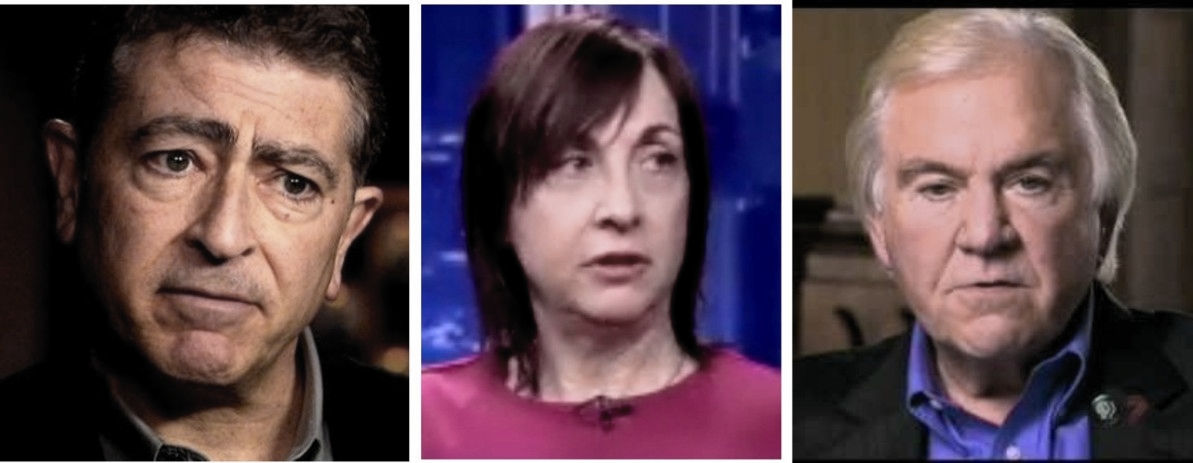
Above: Several of the myth inventors and disseminators: Kassin, Dempsey, Douglas
28. Mignini claimed Meredith was killed in a sex game that went wrong.
Mignini didn’t say anything about there being a sex game that went wrong when he presented his timeline to the court at the trial. Please be warned that there is some extremely graphic content below:
[Timeline of the attack on Meredith]
23:21: Amanda and Raffaele go into the bedroom while Rudy goes to the bathroom.
23:25: A scuffle begins between Amanda, helped by Raffaele, and Meredith. The English girl is taken by the neck, then banged against a cupboard, as shown by wounds to the skull. She resists all this. Rudy Guede enters.
23:30: Meredith falls to the floor. The three try to undress her to overcome her; they only manage to take off her trousers. The girl manages to get up, she struggles. At this point, the two knives emerge from the pockets of Amanda and Raffaele: one with a blade of four to five centimetres, the other, however, a big kitchen knife. Meredith tries to fend off the blades with her right hand. She is wounded.
23:35: The assault continues. Sollecito tries to rip off the English girl’s bra.
23:40: Meredith is on her knees, threatened by Amanda with the knife while Rudy holds her with one hand and with the other hand carries out an assault on her vagina. There is first a knife blow on her face, then straight away another. However, these blows are not effective. The three become more violent. With the smaller knife, Sollecito strikes a blow: the blade penetrates 4 centimetres into the neck.
There is a harrowing cry, which some witnesses will talk about. Amanda decides to silence her, still according to the video brought to court by the prosecutors, and strikes a blow to the throat with the kitchen knife: it will be the fatal wound. Meredith collapses on the floor.
23:45: Meredith is helped up by Rudy and is coughing up blood. The English girl, dying, is dragged along so that she can continue to be undressed.
29. Mignini called Amanda Knox a “she-devil.”
It wasn’t Mignini who called Amanda Knox a “she-devil”; it was Carlo Pacelli, the lawyer who represents Diya Lumumba, at the trial in 2009.
Carlo Pacelli’s comments were widely reported by numerous journalists who were present in the courtroom. Barbie Nadeau describes the moment he asked if Knox is a she-devil in some detail in Angel Face:
“”˜Who is the real Amanda Knox?’ he asks, pounding his fist in the table. “˜Is she the one we see before us here, all angelic? Or is she really a she-devil focused on sex, drugs, and alcohol, living life on the edge?’
“She is the luciferina—she-devil.’” (Barbie Nadeau, Angel Face, Kindle edition, page 124.)
30. Dr Mignini was convicted of a felony and faced prison.
The Florence Appeal Court and Cassation scathingly threw out a malicious prosecution for which both the prosecutor and judge suffered. Dr Mignini has never faced the slightest risk of prison. Often now seen on national TV, Dr Mignini is expected to be the next Prosecutor General of Umbria.
31. Rudy Guede was a drifter.
Rudy Guede lived in Perugia from the age of five, and he had his own apartment at the time of the murder.
32. Guede had a criminal record at the time of the murder.
Rudy Guede didn’t have any criminal convictions at the time of Meredith’s murder. He was not a drug dealer and not a police informant. As Judge Micheli scathingly noted, there is no proof that he committed any break-ins.
33. Guede left his DNA all over Meredith and all over the crime scene.
There was only one sample of Guede’s DNA on Meredith body and there were only five samples of his DNA at the cottage. His DNA was found on a vaginal swab, on the sleeve of Meredith’s tracksuit, on her bra, on the zip of her purse and on some toilet paper in the bathroom that Filomena and Laura shared.
“...also a genetic profile, from the Y haplotype on the vaginal swab, in which no traces of semen were found; DNA on the toilet paper in the bathroom near the room of Mezzetti, where unflushed faeces were found; on the bag found on the bed; on the left cuff of the blue sweatshirt (described as a “zippered shirt” in the first inspection, discovered smeared with blood near the body and partly underneath it); and on the right side of the bra found by the foot of Kercher’s body”¦” ( Judge Giordano sentencing report, page 5.)
34. Guede left his semen at the crime scene.
Guede’s DNA semen wasn’t found at the crime scene.
“...also a genetic profile, from the Y haplotype on the vaginal swab, in which no traces of semen were found”¦” (Judge Giordano sentencing report, page 5.)
“In one of these swabs was found biological material belonging to a male subject identified as Rudy Hermann Guede. This material, which turned out not to be spermatic [158], could be from saliva or from epithelial cells from exfoliation”¦” (Massei report, page 158.)
35. Guede left his DNA inside Meredith’s bag.
According to the Micheli report, which was made available to the public in January 2009, Guede’s DNA was found on the zip of Meredith’s purse, and not inside it.
“...b) traces attributable to Guede: ...on the bag found on the bed”¦” (Judge Giordano sentencing report, page 5.)
36. Guede left his bloody fingerprints all over the crime scene.
He left zero fingerprints. According to the Micheli report, the Massei report and Rudy Guede’s final sentencing report, Guede was identified by a single bloody palm print:
“...b) traces attributable to Guede: a palm print in blood found on the pillow case of a pillow lying under the victim’s body ““ attributed with absolute certainty to the defendant by its correspondence to papillary ridges as well as 16-17 characteristic points equal in shape and position”¦” (Judge Giordano sentencing report, page 5.)
It is confirmed that Guede was identified by a bloody palm print in the Micheli report (pages 10-11) and the Massei report (page 43).
37. Guede left his hair at the crime scene.
The Scientific Police didn’t find any hair that belonged to Rudy Guede at the crime scene. That’s why there’s no mention of this in any of the court documents.
38. Guede pleaded guilty or confessed.
Rudy Guede has never pleaded guilty or confessed to Meredith’s murder. He offered to testify against Knox and Sollecito at trial in 2009, but the prosecutors did not want to give him any breaks.
39. Guede’s prison sentence was reduced because he made a deal with the prosecutors.
Guede was sentenced to 30 years in prison by Judge Micheli in 2008. However, his sentence was reduced because he opted for a fast-trial, which means he automatically received a third off the sentence of Knox and Sollecito. Generic mitigating circumstances—i.e., his young age—were also taken into consideration.
40. Guede didn’t implicate Knox and Sollecito until much later.
Rudy Guede first implicated Knox and Sollecito whilst on the run in Germany on 19 November 2007 in an intercepted Skype conversation with his friend Giacomo:
Giacomo: “So they [Knox and Sollecito] killed her while she was dressed.”
Guede: “Yes, here it says that they [clothes] were washed in the washing machine, but that’s not true. She was dressed.”
41. Amanda Knox didn’t know Rudy Guede.
Amanda Knox testified in court that she had met Rudy Guede on several occasions.
Here’s the court transcript:
Carlo Pacelli (CP), Patrick Lumumba’s lawyer: In what circumstances did you meet him (Rudy)?
Amanda Knox (AK): I was in the center, near the church. It was during an evening when I met the guys that lived underneath in the apartment underneath us, and while I was mingling with them, they introduced me to Rudy.
CP: So it was on the occasion of a party at the house of the neighbors downstairs?
AK: Yes. What we did is, they introduced me to him downtown just to say “This is Rudy, this is Amanda”, and then I spent most of my time with Meredith, but we all went back to the house together.
CP: Did you also know him, or at least see him, in the pub Le Chic, Rudy?
AK: I think I saw him there once.
CP: Listen, this party at the neighbors, it took place in the second half of October? What period? End of October 2007?
AK: I think it was more in the middle of October.
42. Raffaele Sollecito had never been in trouble with the police.
Raffaele Sollecito had a previous brush with the police in 2003.
“...Antonio Galizia, Carabinieri [C.ri] station commander in Giovinazzo, who testified that in September 2003 Raffaele Sollecito was found in possession of 2.67 grams of hashish.” (Massei report, page 62.)
43. Sollecito had an impeccable track record.
Sollecito was monitored at university after being caught watching hardcore pornography featuring bestiality:
“...and educators at the boy’s ONAOSI college were shocked by a film “˜very much hard-core…where there were scenes of sex with animals with animals,’ at which next they activated a monitoring on the boy to try to understand him. (Pages 130 and 131, hearing 27.3.2009, statements by Tavernesi Francesco).” (Massei report, page 61.)
44. Sollecito couldn’t confirm Knox’s alibi because he was sleeping.
The claim that Sollecito couldn’t confirm Knox’s alibi because he was sleeping is completely contradicted by Sollecito’s witness statement:
“Amanda and I went into town at around 6pm, but I don’t remember what we did. We stayed there until around 8:30 or 9pm.
“At 9pm I went home alone and Amanda said that she was going to Le Chic because she wanted to meet some friends. We said goodbye. I went home, I rolled myself a spliff and made some dinner.” (Aislinn Simpson, The Daily Telegraph, 7 November 2007.)
Police said Raffaele Sollecito had continued to claim he was not present on the evening of the murder. He said:
“I went home, smoked a joint, and had dinner, but I don’t remember what I ate. At around eleven my father phoned me on the house phone. I remember Amanda wasn’t back yet. I surfed on the Internet for a couple of hours after my father’s phone call, and I stopped only when Amanda came back, about one in the morning, I think. (The Times, 7 November 2007.)
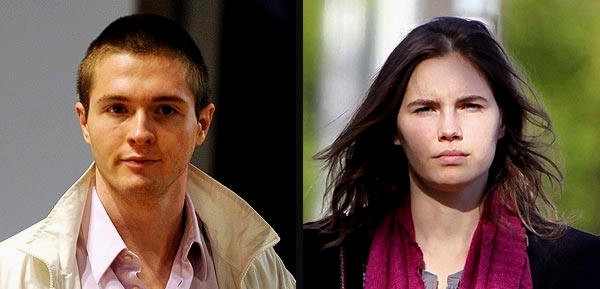
Above: The two provisionally convicted who originated some of the cancerous myths.
45. Amanda Knox had never been in trouble with the police.
According to Andrew Malone in an article on the Mail Online website, Amanda Knox was charged with hosting a party that got seriously out of hand, with students high on drink and drugs, and throwing rocks into the road, forcing cars to swerve. He claimed the students then threw rocks at the windows of neighbours who had called the police. Knox was fined $269 (£135) at the Municipal Court after the incident (crime No: 071830624).
Barbie Nadeau also reported that Knox had had a previous brush with the law:
...and her only brush with the law was a disturbing-the-peace arrest for a house party she threw.” (Barbie Nadeau, Angel Face, Kindle edition, page 6.)
According to the police ticket written by Seattle Police officer Jason Bender, Knox was issued with an infraction for the noise violation and warned about the rock throwing:
I issued S1/Knox this infraction for the noise violation and a warning for the rock throwing. I explained how dangerous and juvenile that action was.
46. Amanda Knox was retried for the same crimes.
All criminal cases in Italy are subject to three levels of review. No verdict is final until it has been confirmed by the Supreme Court.
Amanda Knox was not retried. She simply appealed her provisional 2009 convictions. The first appeal was held in Perugia in 2011, where she was provisionally acquitted by Judge Hellmann.
However, the Italian Supreme Court annulled the acquittals because Hellmann was found to have made a series of grave legal errors, and ordered a new appeal in Florence.
47. The Italian Supreme Court ruled that Amanda Knox’s interrogation was illegal.
The Italian Supreme Court has never stated that Amanda Knox’s recap/summary session on 5 November 2007 for the building of a list of names was illegal.
Bruce Fischer, who runs the Injustice in Perugia website and had heatedly denied this, eventually admitted this was not true on Perugia Murder File.net website:
“When it comes to the admissibility of the written statements, you are technically correct. The interrogation itself was never ruled illegal.”
Note that as stated above it was not an interrogation.
48. The Supreme Court threw out Amanda Knox’s statements.
The Supreme Court ruled that the 1:45am and 5:45am statements Knox insisted upon couldn’t be used against her in the murder trial because she wasn’t represented by a lawyer when she made them, even though she declined the presence of a lawyer.
However, both her statements were used against her at the calunnia component of the trial.
49. Dr. Stefanoni and the forensic technicians broke international protocols.
There is no internationally accepted set of standards. DNA protocols vary from country to country, and in America they vary from state to state. For example, New York state accepts LCN DNA tests in criminal trials.
Conti and Vecchiotti cited obscure American publications such as the Missouri State Highway Patrol Handbook and the Wisconsin Crime Laboratory Physical Evidence Handbook, not international protocols.
50. Amanda Knox is being railroaded or framed.
It would be immensely difficult in the Italian system for police or prosecutors to frame anyone and sustain this through two levels of appeal. With all its checks and balances and its professional career paths, it may be the system least prone to false final convictions in the world.
A number of Knox’s supporters, including Judy Bachrach, Paul Ciolino and Steve Moore, have claimed in the US media that Amanda Knox is being railroaded or framed, but they mis-state multiple facts and provide no hard proof or any reason why. The Hellmann appeal was wiped off the books, but they wrongly still draw upon that.
The collection of the DNA and forensic evidence was videotaped by the Scientific Police and, as the judges at the Supreme Court noted, defence experts were actually in the police labs to observe the DNA tests and reported nothing wrong:
“...the probative facts revealed by the technical consultant [Stefanoni] were based on investigative activities that were adequately documented: sampling activity performed under the very eyes of the consultants of the parties, who raised no objection”¦” (The Supreme Court report, page 93.)
The legal proceedings against Sollecito and Knox have been monitored throughout by US officials from the Rome embassy, and they at no time have ever expressed any concerns about the fairness or legitimacy of the judicial process.
Sources
Court documents
The Micheli report
The Massei report
Judge Giordano sentencing report
The Supreme court report
The Nencini report
Court testimony
Amanda Knox
Anna Donnino
Monica Napoleoni
Articles
The Daily Mail
The Times
The Telegraph
The Daily Beast
The Seattle Post-Intelligencer
Books
Death in Perugia, Kindle edition, John Follain
Angel Face, Kindle edition, Barbie Nadeau
Television programmes
Drew Griffins’ interview with Giuliano Mignini on CNN
Websites
The Freelance Desk: http://thefreelancedesk.com
Perugia Murder File.org: http://www.perugiamurderfile.org
Perugia Murder File.net: http://perugiamurderfile.net
CPS website: http://www.cps.gov.uk/publications/prosecution/lcn_testing.html
Seattle-Post Intelligencer: http://blog.seattlepi.com/seattle911/files/library/knoxincidentreport.pdf
Sunday, May 11, 2014
Knox Interrogation Hoax #1: Masterlist Of Posts Re Pre-Trial Events And Hoax Overview
Posted by Our Main Posters
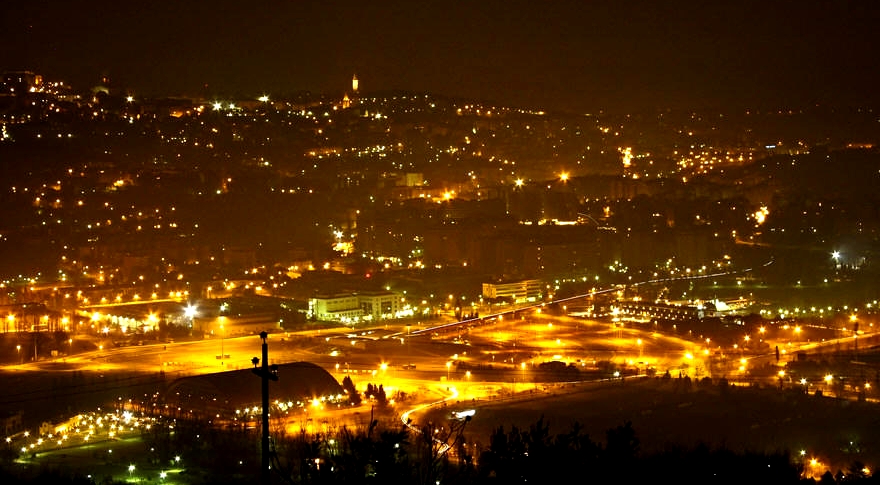
Perugia Central Police Station at night (left-center)
1. Masterlist Of Posts In The Series
The Interrogation Hoax series will consist of a total of 24 posts.
These posts quote from a large number of transcripts only recently acquired and translated. There are no serious conflicts, no gray areas. One can assume with total certainty that this is the real thing (see Part 3 below), and that any other versions (see Part 4 below) are fabricated.
Numbering of posts 1-24 is not chronological, it represents the original order of postings.
1. What Happened At AK & RS Q&A Prior To 6 Nov
Click for Post: #19: ALL Knox Q&A Sessions 2-6 November 2007 WERE Recorded #1
Click for Post: #20: ALL Knox Q&A Sessions 2-6 November 2007 WERE Recorded #2
2. What Happened At Knox Q&A 6 Nov Ending 1:45 AM
Click for Post: #2: Trial Testimony From Rita Ficcara On Realities 5-6 Nov
Click for Post: #3: More Defense Pussyfooting Toward Rita Ficcara, Key Witness
Click for Post: #4: More Hard Realities From Rita Ficcara, More Nervousness From Defense
Click for Post: #12: Ficarra & Knox Notes PROVE Knox Merely Worked On Visitors Names List
Click for Post: #5: Key Witness Monica Napoleoni Confirms Knox Self-Imploded 5-6 Nov
Click for Post: #7: Testimony Of Witness Lorena Zugarini On The Knox Conniption 5-6 Nov
Click for Post: #8: Testimony Of Interpreter Donnino On Events Night Of 5 November
3. What Happened At Sollecito Q&A 6 Nov Ending 3:30 AM
Click for Post: #6: Sollecito Transcript & Actions Further Damage Knox Version
Click for Post: #9: Officer Moscatelli’s Recap/Summary Session With Sollecito 5-6 Nov
4. What Happened At Knox-Rights Session Ending 5:45am
Click for Post: #15: Knox Is Told Her Rights And Repeats Fake Murder Charge
5. What Of Relevance Happened In Ensuing Months
Click for Post: #13: The First Two Pre-Trial Opportunities Which Knox Flunked
Click for Post: #14: The Third Pre-Trial Opportunitty Which Knox Flunked
Click for Post: #16: The Fourth Pre-Trial Opportunity Which Knox Flunked
Click for Post: #17: Sollecito April 2008 Before Supreme Court Again Coldshoulders Knox
Click for Post:#18: The Final Pre-Trial Opportunities Which Knox Flunked
Click for Post: #21: Illustrating How Batshit Crazy The Interrogation Hoax Has Become
6. Why Investigators’ Version Won Hands-Down At Trial
Click for Post: #10: Why Prosecution And Defenses Never Believed Knox’s Version #1
Click for Post: #11: Why Prosecution And Defenses Never Believed Knox’s Version #2
2. Explaining Overall Arc Of Events
Much of the testimony listed above was about events at the central police station pre-arrest in early November 2007 and subsequent court attempts to achieve some believability and relief.
Early in 2009 at trial Knox and Sollecito sat glumly through all of the investigators’ pre-arrest testimony and cross-examination at trial. They were downhearted and apprehensive, and there were no smiles and few interruptions.
Subsequently Sollecito chose not to get on the stand, so from his team there really was never a rebuttal.
But Knox HAD to get on the stand, in July, for two days. She had no other way to defend herself against the serious felony crime of falsely framing Patrick for murder.
It was her word against theirs. It contradicted in many places what she had heard months earlier in sworn testimony from many investigators.
Knox’s version inevitably weakened a lot under cross-examination, and was ultimately a fail at trial and several appeals, even the annulled one.
Knox ended up serving three years. While on the stand she confirmed that she had been treated well, stiffing thousands of supporters duped into believing she had not been.
3. Explaining Court-Accepted Narrative For 6 Nov
This is an overview of Knox’s so-called “interrogation” at Perugia’s central police station, the subject of the first ten posts.
It led to her arrest and three years served. To make this picture really firm we will quote a lot of the testimony at trial. The Case Wiki carries all of these transcripts, many in English translation, and more.
Senior Inspector Rita Ficarra testified that she arrived back at the police station late on 5 November, and finds her way blocked by a cartwheeling Knox.
She rebukes Knox, who testily responds that she is tired of the investigation. Rita Ficarra tells Knox to go home and get some sleep. Knox testily refuses, and remains there.
Shortly after, Ficarra suggests to Knox that if she really wants to help, she could add to the list of possible perps - men who Meredith knew and who might have visited the house.
This was a recap/summary, a simple checking of facts with someone who might or might not be of help. This could have been done on a street corner or in a house by a single officer. It was not a witness or suspect interrogation. From the transcript:
Ghirga: “While this interrogation - let’s call it thus - was in progress, some colleagues arrive…” Ficarra: “It was not an interrogation, Attorney.” Ghirga: “They are called recaps/summaries.
Knox eagerly agrees. So they begin on the list.
This goes slowly because of language problems, until an interpreter, Anna Donnino, arrives. In total only Knox and four others (three of them women) are present.
Knox builds a list of seven people and adds maps and phone numbers (placed in evidence) in a calm proceeding. These were the names: Peter Svizzero, Patrick, Ardak, Juve, Spiros, Shaki and “a South African [Guede]” who played basketball near the house.
At several points in the evening Knox is provided with refreshments. No voices are ever raised, no bathroom breaks are refused.
In a separate wing Inspector Napoleoni and a couple of colleagues are seeking facts from Sollecito. Shown conflicts between what he has said and what his phone records show, Sollecito backtracks, and declares that Knox went out alone on the night, and made him lie.
Napoleoni moves through the questura to suggest to Ficarra to discuss the night of the attack with Knox in more detail and clarify who might have been present. Knox is not informed of Sollecito’s backtrack. She is asked for more names and spontaneously shares her phone. There is an outgoing to Patrick but no prior incoming. Knox is asked who Patrick is.
Suddenly, to the considerable surprise of others present, Knox has a yelling, head-clutching conniption (the first of several that night) and says “It’s him, it’s him, it was him, he killed her”. The session is halted.
Despite warnings she should not do so without a lawyer, Knox insists on a recorded statement which says she headed out to meet Patrick that night after he texted her. She accuses Patrick of killing Meredith.
Efforts are made throughout the next several hours to try to help Knox to calm down. Knox is put on hold, given more refreshments, and made comfortable on some chairs so she might try to get some sleep.
A second session ending at 5:45 is intended as merely a formal reading of Knox’s legal status and her right to a lawyer, with Dr Mignini presiding. She is to be held as a material witness and for her own protection.
Again warned that she should not speak without a lawyer, and no questions can be asked, Knox still insists on a second spontaneous accusation culminating in a second recorded statement.
This also says she went out to meet Patrick that night, also accuses Patrick of killing Meredith, and now also hints that Sollecito may have been there.
Just before noon, now under arrest and about to be taken to Capanne Prison, Knox insists on writing out at length a third statement this time in English.
She gleefully hands it to Rita Ficcara who cannot read it as she as no English. In the statement, Knox included this damning remark, without any mention of having been coerced: “The questions that need answering, at least for how I’m thinking are… 2. Why did I think of Patrik?”
Knox’s lawyers never ever substantially challenge this version, and never lodge any complaint. At trial in 2009 they accept on the record that there was no interrogation, and leave standing that Knox insisted on all three statements, and dont ever pursue Knox’s claims that she was coerced.
Courts all noted that there is no mention in that third note of Knox having been coerced, although this note was her idea and she could put in it anything she liked. From this there never was any going back.
In July 2009 at trial, in face of days and days of prior investigator testimony, Knox brashly tried to substitute this scenario above with the one below. Of course she was disbelieved.
For the calunnia framing of Patrick Lumumba Judge Massei in 2009 sentenced her to a year more than Sollecito, amended by Judge Hellmann in 2011 to three years served.
The Supreme Court definitively overruled her calunnia appeal so for her false framing of Patrick she is a felon for life.
4. Explaining Knox Family & PR Alternative
Knox’s Italian lawyers were not a part of this; in contrast the American PR lawyer Ted Simon sought to introduce major confusion.
In Italy, lawyers are REQUIRED to report tales of abuse of their clients or face possible criminal charges. Contrariwise, if they knowingly report false charges they can face similar charges. So what they do is a strong indicator of truth.
Amanda Knox’s lawyers not only did not ever report any abuse. They even announced publicly, in face of incessant claims of abuse by Knox, family, and PR forces, that they had seen no evidence of abuse and so would not be reporting.
Though her precise claims vary and often contradict one another, Knox herself has on and off ever since November 2007 tried to put the investigators on trial - tried to blame the police for causing her conniption and her false accusation of Patrick for the death of Meredith.
Her fail rate has been spectacular.
Knox failed to convince (1) Supervising Magistrate Matteini and (2) the Ricciarelli review panel in November 2007, (3) failed to convince Prosecutor Mignini in December 2007, (4) failed to convince the Supreme Court in April 2008, (5) failed to convince the Micheli court in late 2008, (6) failed to convince the judges and jury at trial 2009, (7) failed at annulled appeal 2011, (8) failed at repeat appeal 2013, (9) failed to convince the Supreme Court in 2012 and (10) failed again in 2015.
As Knox’s team simply did not ever believe her, they may not have given this their hardest shot. It was not part of their largely spurious complaint to the EC HR.
And yet despite all of these failures, the huge and very nasty Knox PR effort went full-bore ahead with the abuse allegations anyway.
Read this post of 11 February 2009 which was about two weeks before the Knox “interrogators” were cross-examined at trial, and several months before Knox herself took the stand. Dozens of media reports repeated the Knox claims as if true.
Knox repeated them in her April 2013 book, and her December 2013 email to Judge Nencini, and her appeal to EHCR Strasbourg, and in some TV and newspaper interviews, including one with the Italian weekly Oggi which caused that paper legal harm.
This version has been blown up by Knox PR shills in internet posts, articles, TV interviews, and books. Among others propagating it have been Raffaele Sollecito (in his book), Doug Preston, Saul Kassin, Steve Moore (especially), John Douglas, Jim Clemente, Paul Ciolino, Michael Heavey, Greg Hampikian, Chris Halkidis, Mark Waterbury, Doug Bremner, Candace Dempsey, Nina Burleigh, Bruce Fischer, and many posters on the Knox sites and Fischer sites and on Ground Report.
Main claims included 50-plus hours of “interrogation”, numerous officers in teams, no food or drink, no sleep, no bathroom breaks, no lawyer, no recording, and much abuse and yelling and suggestions and threats. Way beyond anything even Knox herself and notably her own lawyers ever claimed.
- Here is Steve Moore claiming that around a dozen cops in rotating tag teams of two assaulted a starving and sleepless Knox over 20/30/40 hours, threatened her, and refused her a lawyer throughout.
- Here is Saul Kassin claiming that Knox was interrogated over the entire night of 5-6 November, until she was finally broken and a coerced “confession” emerged - even though the “false confession” actually framed Patrick and was in reality a false accusation. That Kassin ignores.
- Here are several former FBI profilers blatantly embellishing the same claims in a book, with (today) 60 five-star reviews.
And yet Knox’s own Italian lawyers specifically denied her accusations! No complaint against the police was ever lodged. All courts disbelieved her. Knox served her three years. But still the PR-driven hoax keeps resounding.
Tuesday, April 29, 2014
Why Final RS & AK Appeal Against Guilty Verdict May Fail: Multiple Wounds = Multiple Attackers
Posted by Our Main Posters
Reports From Italy On Why AK & RS Appeal Failed
The Nencini Report has been released and we are seeing to its translation right now.
Meanwhile journalists in Italy have these reports which convey the very implacable, damning tone. There was nothing accidental about Meredith’s death; Knox premeditated it all along.
First report
From Il Messagero kindly translated by Miriam:.
FLORENCE - The knife that was seized at Raffaele Sollecito house is the knife that killed Meredith Kercher, and the blow was delivered by Amanda Knox. So writes the President of the Court of Appeal of Florence, Alessandro Nencini, in the motivation report of the sentence that was passed on Jan. 30th that saw Amanda Knox sentenced to 28 and a half years and Raffaele Sollecito to 25 years.
Over 330 pages in which the court covers the appeal and explains the conviction. Starting with the knife considered “not incompatible with the wound that was carried out on Meredith Kercher. “In the present case, writes Nencini what counts is the accessibility of the weapon by the accused, it’s concrete portability from house to house, it’s compatibility with the wound, and the presence of Meredith’s DNA on the blade. All of these elements ascertained by the court lead to the conclusion that the knifed evidenced as no. 36 was one of the knifes used in the attack, and was the knife that Knox used to strike the fatal blow to Meredith’s throat.”
The court retains to have sufficient evidence of “certain reliability” of Rudy Guede (convicted to 16 years) Amanda and Raffaele in the house where Mez was killed, on the night between the 1st and November 2, 2007 in 7 Via della Pergola “in the immediate phases following the murder.” The Court then tells how she was immobilized and Mez “was not able to put up some valid resistance because she was dominated by multiple assailants and cut at the same time with the blades of several knives.”
Rejected therefore is the defense’s strategy of both of the convicted, that have always maintained that the killer was only one.: the Ivorian Rudy Guede.
Second report
Bullet points from various Italian media.
- The big knife from Sollecito’s house held by Amanda Knox caused the fatal wound to Meredith while the other was held by Raffaele Sollecito.
- There is strong “multiple and consistent” evidence of all three in the house immediately following the murder. All three worked to suppress Meredith.
- There was an escalating quarrel between Knox and Meredith leading to a progressive aggression and murder with sexual components.
- Between Amanda and Meredith there was no mutual sympathy and Meredith harbored serious reservations about the behavior of AK.
- The biological trace found on the bra clasp that Meredith Kercher was wearing the night she was murdered was left by Raffaele Sollecito
Third report
No especially accurate reports in English have appeared yet and the erroneous “new trial” is still surfacing. Andrea Vogt tweets that she will be posting an analysis soon.
The mischievous defense-inspired “sex game gone wrong” and “satanic theory” mantras are still widely showing up in the duped media, but are nailed hopefully finally in this new report.
Judge Nencini has closely followed and endorsed the “from all angles” Massei trial analysis, but with the inclusion of some more credible explanations from Prosecutor Crini which Judge Micheli had also espoused back in 2008.
In particular, Rudy Guede is not now highly improbably seen as the one initiating the attack on Meredith, and sex was not at all the primary driving force for the attack (the prosecution never ever said it was). Knox carried the big knife from Sollecito’s for a purpose.
The bad blood between the girls resulting from Knox’s crude, brash, very lazy, drug-oriented behavior was well known in Meredith’s circle. All of them had backed away from her, as also had her employer and the patrons in his bar.
There was a probable theft of money by Knox who was unable to account for a sum similar to what Meredith would have stashed away for the rent and that is seen as the probable spark for the explosive argument and attack.
Fourth report
Barbie Nadeau in The Daily Beast
Amanda Knox apparently did not kill Meredith Kercher in a “sex game gone wrong,” as had been previously decided by a lower court in Perugia, according to a Florentine appellate judge who released today a 337-page document explaining his decision to convict Knox and her erstwhile Italian boyfriend, Raffaele Sollecito, for Kercher’s murder. Rather, the judge claims, Knox allegedly killed Kercher, her 21-year-old British roommate, because she didn’t like her.
All Italian courts require judges to explain the reasoning behind their rulings, and it likely represents the penultimate step in a seven-year case that has seen Knox and Sollecito first convicted in 2009 then acquitted in 2011 then convicted again in January 2014. Rudy Guede, an Ivory Coast native who was also convicted for his role in the murder back in 2008, is serving a 16-year jail sentence. He is currently eligible to apply for work furloughs from prison.
Judge Alessandro Nencini, along with a second judge and six lay jurors, were tasked with hearing a second appeal that began in September 2013 after Italy’s high court threw out the acquittal that set Knox and Sollecito free in 2011. Italy’s high court cited “inconsistencies” and “legal mistakes” and tasked Nencini’s court with hearing the appeal again. It was not a retrial per se, but rather a fresh look at the appeal process that freed Knox.
Nencini decided that the appellate court that set Knox free erred in evidentiary and legal matters. That court will now have to rule definitively on the case, using Nencini’s reasoning and whatever appeal Knox and Sollecito file for their final judgment. If the high court accepts Nencini’s verdicts, the two will be required to serve their prison sentences in Italy. Knox has vowed she will not return to Europe, but Sollecito, unless he escapes, won’t be as lucky.
The court’s explanation of its decision comes down hard on the first appellate court that overturned Knox’s guilty verdict, at times seemingly scolding them for misapplication of penal codes and for throwing out witness testimony without explanation. “It was an operation of evaluating evidence with using logic,” Nencini wrote, accusing the first appellate court of essentially throwing out testimony that allegedly proved Knox’s involvement, but keeping testimony that supposedly supported her innocence.
He used Knox’s prison diary as a prime example. “Look at the contradictions in the evaluation of the diary written in English by Amanda Knox,” he wrote, referring to a handwritten prison diary taken fromKnox’s cell as part of the investigation to determine why she accused her pub boss Patrick Lumumba of Kercher’s murder during early interrogations. “On one hand, the appellate court of Perugia completely devalued the writings when she admitted wrongdoing by accusing Patrick Lumumba. On the other side, they valued it when she defended herself.”
Nencini also ruled that there was plenty of forensic evidence tying Knox and Sollecito to the crime scene, writing “they left their tracks in the victim’s blood” more than once in the document. He accepted testimony that supported the theory that a knife found in Sollecito’s apartment was one of the primary murder weapons, and he reasoned that a second knife was also used that matched a blood stain left on Kercher’s mattress.
The first knife in question was the only hard evidence reexamined in the second appeal, and forensic experts ruled that a previously untested spot on the knife’s handle consisted of 100 percent Knox’s DNA. An earlier court heard testimony that a tiny smidgeon of DNA on the groove of the blade was Kercher’s, but the first appellate court agreed with witnesses who testified that the sample was too small to be considered a perfect match. The second appellate court not only considered the knife to be the murder weapon, it also ruled that Knox “plunged the knife into the left side of Kercher’s neck, causing the fatal wound.”
The second appellate court also reasoned that Kercher’s bra clasp, which had been cut from her body after she was killed, had Sollecito’s DNA on the tiny metal clasp. “The biological trace found on the bra clasp that Meredith Kercher was wearing when she was assassinated belonged to RaffaeleSollecito,” Nencini wrote, agreeing with the judge in the original murder conviction. “The clasp was manipulated by the accused on the night of the murder.”
The court also scoffed at certain rulings laid out by the first appellate court, saying that the court’s reasoning that it would have been easy for “a young athlete” like Rudy Guede to scale the wall and enter the apartment, was borderline racist.
Nencini also ruled that with regard to motive in the murder, it was subjective and personal. “It is not necessary for all the assailants to share the same motive.”
The court picked out small details of Knox’s presumably errant testimony, including how she told police the morning Kercher’s body was found that Kercher always locked her door “even when she takes a shower,” which was later contested by the girls’ other roommates.
Nencini also clearly believed ample forensic testimony, presented by experts examining the original autopsy, that Kercher was killed by more than one person. “”She was completely immobilized when she was murdered,” he said, reasoning that Guede could not have acted alone, and instead likely held her back as Sollecito and Knox knifed her.
The judge also pointed out incongruences in Knox’s testimony about the night of the murder, but noted problems with the other witnesses, which included a homeless man, an elderly woman who said she heard screams. Still, he ruled that Knox’s accusation of Lumumba is vital evidence against her. “It is impossible to separate the two acts,” he wrote.
Using Nencini’s reasoning, Knox’s lawyers now have the roadmap for planning their final appeal to Italy’s high court, likely later this year or in early 2015. However, this same high court threw out the acquittal in the first place, so Knox may need more than luck to walk free. If she is definitively convicted, she will likely face an extradition order to come back to Italy to serve out her sentence. There are very few legal loopholes that would allow an American citizen to escape a court decision by a country, like Italy, that shares extradition treaties with the U.S.
[Judge Massei at crime scene; report says why Knox & Sollecito appeal against his 2009 verdict has failed]
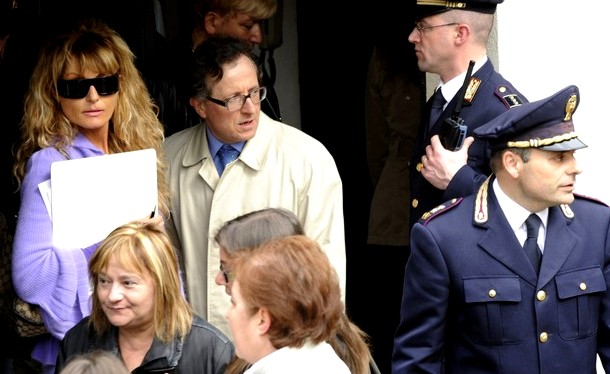
[The Supreme Court in Rome is expected later this year to confirm this outcome]
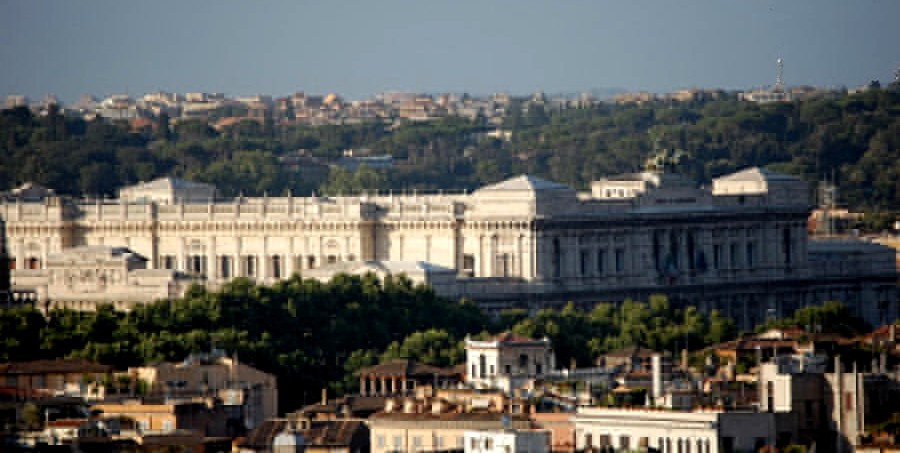
Sunday, April 27, 2014
Knox & Sollecito Actions In The Week Prior To Arrest: An Incriminating Behavior Pattern For Sure
Posted by James Raper
[Video above: Sollecito slams Knox’s weird behavior, while not explaining numerous examples of his own ]
1. Today’s Context To This Post
A very strong case for guilt has been made at trial and endorsed at the first-level appeal.
This series hammers home the growing hundreds of incriminating stark differences between the official evidence record, Sollecito’s and Knox’s two books, and Sollecito’s and Knox’s multiple conflicting claims since.
The focus of this post as with the one immediately below is upon the described behaviours of Knox and Sollecito, from the very beginning to this very day. This pattern has more than contributed to the certainty of their involvement in the murder of Meredith Kercher.
2. How The Behavior Speaks To Guilt
The early pointer of the staged break-in aside this behaviour gave investigators an insight into the pair’s possible involvement back on Day One: Behavioral pointers have continued on a par with corroborated developments in the case.
It has even continued, incredibly, since their release from prison. For me it is the thread that runs through this case having as much to do with the overall picture of culpability as the other elements .
This behaviour - to include what they have to say for themselves - is a catalogue of the inappropriate, of the implausible, of inconsistencies and contradictions, of evasions and obfuscations, to be gleaned from the accounts of Knox and Sollecito themselves and highlighted in the accounts of other witnesses. It is also to be gleaned from phone and computer records.
Taken together it is a formidable body of evidence which goes to character and culpability. It cannot be attributed to a railroading job, the machinations of a corrupt and evil prosecutor or character assassination by the media. It is also implausible if not impossible to explain it as being due to naivety, confusion or some quirkiness of character.
It amounts to the pair of them concocting stories, telling lies and misleading investigators and the general public.
3. Physical Evidence Array Is Already Substantial
There are numerous items of evidence which are building blocks in the prosecution case and with which we are all familiar.
- 1. The staged break-in via Filomena’s window with pointers to this outside, on the windows and shutters, and throughout the bedroom.
2. The evident partial clean up proved by footprint trails with footprints missing and what was behind the locked door.
3. Amanda Knox’s lamp on the floor behind Meredith’s locked door which she only conceded was her own at trial, under pressure.
4. Knox’s dried and congealed blood on the tap in the small bathroom that Amanda Knox and Meredith shared.
5. The bloody footprint on the mat in that bathroom definitively attributed to Sollecito rather than Guede
6. The mixed DNA of Knox and Meredith Kercher found in blood in the basin, the bidet and on the box of Q tips in that bathroom
7. Two luminol enhanced mixed traces containing DNA belonging to Knox and Meredith Kercher, one in the corridor and the other in Filomena’s room
8. Two luminol enhanced footprints of Knox in the corridor and one of Sollecito immediately outside Meredith’s room.
9. The knife taken from Sollecito’s apartment with Meredith Kercher’s DNA on the blade and Knox’s DNA on the handle and on the blade
10. Meredith Kercher’s bra clasp with Sollecito’s DNA on a hook and contamination possibilities definitively ruled out.
4. Behaviors In The First Week Of November 2007
I don’t want to make this an unduly long post. Accordingly I am going to concentrate on the period up to that famous police interrogation analysed just below. As to that critical period I will be selective but it should be enough.
The Lady With The Mop?
The story (in Knox’s e-mail) that she had visited the cottage to collect a mop, have a shower and get a change of clothing, earlier on the morning of the 2nd November, but did not notice that Filomena’s window had been broken and her room trashed is just that - a made up story. It is entirely implausible and the account unreliable for a number of reasons including-
- (a) it is hard to believe that she did not notice the hard to miss fact that the shutters to Filomena’s window were (as they were found) open - this would have alerted her to the likelihood that Filomena was back home which she would, of course, have checked out of curiosity if nothing else given that she found no one home.
(b) her claim that Filomena’s door was shut is contradicted by Sollecito who wrote (prison diary) that when he later entered the cottage with Knox Filomena’s door was wide open.
(c) it is hard to believe that she took a shower without noticing until after her shower (as she claimed) that there was blood on the bathroom mat, including a bloody footprint. In fact she didn’t even claim to notice that it was a footprint despite the fact that it was obviously so.
(d) it is hard to believe that having found the front door wide open and having found blood, and having opted for a shower and to blow dry her hair, she never got round to checking for any sign of Meredith’s presence. Any one else would have tried her door to check whether or not she was home.
(e) from her appearance at the cottage that morning it is hard to believe that she took a shower at all (let alone blow dried her hair) and the cops remarked that she reeked of body odour.
(f) less problematic but nevertheless still somewhat surprising is that as she is drying her hair she makes a fuss over shit (left by Guede) in the toilet, describes herself as being “uncomfortable” about it but does not flush it away before grabbing the mop and leaving.
The Two Stayed At Home?
The story that Knox and Sollecito had spent the previous night (the night of Meredith’s murder) indoors, critically from 9 pm onwards, that both had slept and that Knox had been the first to rise at about 10.30 am the next morning is implausible and uncorroborated, not only because this alibi is directly contradicted by the testimony of Curatolo and Quintavalle, and Sollecito’s statement to the police that Knox had gone out and not returned until about 1 am, but also in view of the following facts.
- (a) Curatolo claimed to have first seen the Knox and Sollecito in Piazza Grimana shortly after 9.30 pm but Knox claimed in her trial testimony that she and Raffaele had cooked and eaten a meal between 9.30 and 10 pm.
GCM: Can you say what time this was?
AK: umm, around, umm, we ate around 9.30 or 10, and then after we had eaten, and he was washing the dishes, well, as I said, I don’t look at the clock much, but it was around 10. And”¦he”¦umm”¦well, he was washing the dishes and, umm, the water was coming out and he was very bummed, displeased, he told me he had just had that thing repaired. He was annoyed that it had broken again. So”¦umm
LG: Yes, so you talked a bit. Then what did you do?
AK: Then we smoked a joint together”¦”¦we made love”¦..then we fell asleep.
Unfortunately Sollecito’s father himself torpedoed this dodge by telling the court that when he phoned his son at 8.42 pm Sollecito had told him that there had been a water leak while he was washing the dishes. Taking into account Knox’s testimony that they had eaten before the dish washing, this places the meal and dish washing before that call.
(b) Sollecito told the police that at about 11 pm he had received a call from his father on his land line. Not only is that not confirmed by his father but there is no log of such a call.
(c) There is no log of a call to his mobile at that time either though his father had sent a text message at that time but which Sollecito did not receive until 6. 03 am the following morning. We know that he had received it at that time because that is the time at which it is logged in the phone records. Sollecito had just turned his phone on and clearly the phone had been off when the text message was sent.
(d) There is no record of any phone activity for either of them from after the 8.42 pm call to, in Sollecito’s case, receipt of that text message at 6.03 am, and in Knox’s case her call to Meredith’s English phone at 12.07 pm the next day.
A further word about this Point (d) here as Knox has released her phone records on her web site. In her case it has to be said that this is not so unusual. Up until the 30th October there is no regular pattern of late or early morning phone activity.
It is interesting to note, however, that as of the 30th October there is a spate of texts and calls between her and a young Greek known to us as Spiros. Communication between them had in fact been going on since the beginning of October but there are 5 texts in the afternoon of the 30th, two telephone calls in the afternoon and a call at 11.38 pm on Halloween.
In the early hours of the following morning there are a couple of calls between the two. In fact we know that the two met up together for Halloween as Knox was at a loose end. Meredith had shrugged her off and Raffaele was attending a friend’s graduation dinner out of town.
Sollecito is different as his father was in the habit of calling at all hours just to find out what his son was doing and, as we know, he had called late only to find that his son’s phone was switched off.
In the case of Knox she admitted in any event that her phone had been switched off, “to save the battery”.
(e) There is no record of any activity on Sollecito’s computer after 9.15 pm and until 5.32 am the following morning when music was played for half an hour. This contradicts the claim that Sollecito had smoked pot and interacted with his computer until midnight and that they had both slept until late the following morning.
(f) The fact that the next morning, outside the cottage, both Knox and Sollecito looked utterly exhausted. This belies the alibi that they had spent a quiet night indoors and had only risen late that morning.
The Fake Call To Knox’s Mum in Seattle?
Knox falsely claims in her book that having had her shower she called her mother on her way back to Sollecito’s apartment as she was beginning to have concerns as to what she had seen at the cottage. Her mother tells her to raise her concerns with Raffaele and the other flatmates and Knox says that she then immediately called Filomena. Filomena tells her to get hold of Meredith by phone which she tries to do by calling Meredith’s English phone first, then her Italian one.
- (a) How does this correlate to the contents of her e-mail of the 11/04/07?
(b) How does this correlate to Knox’s phone records?
(c) There is no mention of a call to her mother at all in the e-mail. This from her e-mail -
“”¦.and I returned to Raffaele’s place. After we had used the mop to clean up the kitchen I told Raffaele about what I had seen in the house over breakfast. The strange blood in the bathroom, the door wide open, the shit in the toilet. He suggested I call one of my roommates, so I called Filomena”¦”¦”¦..
Filomena seemed really worried so I told her I’d call Meredith and then call her back. I called both of Meredith’s phones the English one first and last and the Italian one in between. The first time I called the English phone it rang and then sounded as if there was disturbance, but no one answered. I then called the Italian phone and it just kept ringing, no answer. I called the English phone again and this time an English voice told me the phone was out of service.”
(d) the phone records are as follows for 2 November 2007:
Ist call of the day @ 12.07.12 (to Meredith’s English phone) - 16 seconds
2nd call @ 12.08.44 (to Filomena) - 68 seconds
3rd call @ 12.11.02 (to Meredith’s Italian phone) - 3 seconds
4th call @ 12.11.54 (to Meredith’s English phone) - 4 seconds
8th call @ 12..47.23 (first call to her mother) - 88 seconds
(e) The discrepancies are numerous, see these examples:
1. The first call to her mother was not just after leaving the cottage but 40 minutes after the call to Filomena, and the call to Filomena had been placed after she had returned to Raffaele’s place and after they had used the mop and had breakfast. In fact, say about an hour after she left the cottage.
2. The first call to Meredith’s English phone was placed before the call to Filomena, and not after as Knox would have it in her e-mail. A minute before, but Knox did not mention this to Filomena, as confirmed by the e-mail and Filomena’s testimony.
3. The first call to Meredith’s English phone disappears entirely in Knox’s book.
4. The call to the Italian phone did not just keep ringing. The connection was for 3 seconds and this was followed by a connection to the English phone for 4 seconds.
5. The English phone was not switched off or out of service. Mrs Lana’s daughter had found it. She said that she would not have done so but for it ringing (the 12.07 call for 16 seconds?). She picked it up and took it into the house where it rang again (the 12.11 call - 4 seconds?). A name appeared on the screen as it rang : “Amanda”.
6. The 3 and 4 second calls are highly suspicious. The Italian phone was undoubtedly in the possession of the postal police. According to Massei it’s answering service was activated, accounting for the log. Clearly Knox did not even bother to leave a message for Meredith as it would take longer than 3 seconds just to listen to the answering service. This is not the behaviour of someone genuinely concerned about another.
- Observations:
1. In her e-mail, and repeated in her trial testimony, Knox says that she woke up around 10.30 am, grabbed a few things and walked the 5 minutes back to the cottage. If the first call to her mother was about an hour after she left the cottage (see before), then she left the cottage at about 11.47 am, which means that she spent over an hour there. Either that or she spent more (a lot more) than 20 minutes at Raffaele’s place before calling Filomena. The latter would be more likely as it is difficult to conceive that she spent over an hour at the cottage. She didn’t have the heating on when she was there. Either way there is a period of about an hour and a half between when she might have tried to contact Meredith or raise the alarm and actually doing so.
2. That we are right to be incredulous about this is borne out by the false claim in Knox”˜s book. That false claim is significant and can only be because Knox is aware of the problem and feels she needs to add some support to her implausible story of the mop/shower visit and to conceal the real reasons for the inactivity and delay connected with it.
3. That it is incredible is even belatedly acknowledged by Sollecito’s feeble but revealing attempt to distance himself from Knox in a CNN interview on the 28 Feb this year. “Certainly I asked her questions” he said. “Why did you take a shower? Why did you spend so much time there?”
4. That she makes that false claim and has constantly stonewalled and/or misplaced the 16 second call to Meredith’s English phone is indicative of her guilty knowledge. Her guilty knowledge with respect to the 16 second call was that it was made to ascertain whether or not the phones had been located before she called Filomena, and hence for her it was not (incredulous though this is without such explanation) a pertinent fact for her to bring up with Filomena.
The Real Call To Knox’s Mum In Seattle?
As to the 12.47 call to her mother itself (4.47 am Seattle time and prior to the discovery of Meredith”˜s body) Knox not only did not mention that in her e-mail but in her trial testimony she steadfastly declined to recall that it had occurred.
She clearly did not want, or could not be trusted, to discuss why the call had occurred and what had transpired in conversation with her mother before the discovery of Meredith’s body.
Not only was the timing of the 12.47 call inconvenient to her mother but I found it interesting to note from Knox’s phone records (covering 2nd Oct - 3rd November) that mother and daughter do not appear to have called or texted each other once up until that 12.47 call.
It would appear then that in so far as they remained in direct communication with each other for that period it must have been by e-mail. One can therefore imagine that her mother was very surprised to receive that call.
It is also very difficult to accept that Knox could not recall a phone call she was not in the habit of making. (On the other hand the same records show that it was not at all unusual for Knox and Meredith to communicate with other on Meredith’s English phone.)
Sollecito’s Call From His Dad?
At the cottage, and prior to the above call, Sollecito received a call from his father at 12.40 am. Do we know what they discussed? It would in any event have been after the discovery of Filomena’s broken window and (allegedly) Sollecito’s (rather feeble) attempt to beak down Meredith’s door.
Did the responsible adult advise his son to do the obvious and call the police? One would think so, but then why was there a 10 minute delay before he called his sister in the Carabinieri at 12.50 am? Indeed, why call his sister at all? Filomena had also urged Knox to call the police when she called at 12.35.The delay might be explained by the unexpected arrival of the postal police and if this was the case then it was before Sollecito called the 112 emergency services.
The Claims Of Finding Meredith’s Body?
Neither Knox nor Sollecito saw into Meredith’s room when the door was broken down and her body discovered on the floor under a quilt. Yet in the immediate aftermath it is as if they have wanted others to believe that it was they who discovered her body and in the bragging about this there have been disclosures, not only as to what they should not have been aware but also suggestive of disturbed personalities. This behaviour was remarkable for all the wrong reasons.
- (a) Luca Altieri”˜s testimony makes it clear that Knox and Sollecito had heard about Meredith”˜s cut throat directly from him during the car ride to the police station.
However her bizarre and grotesque allusion in the early moments of the investigation to the body being found stuffed into the closet (wardrobe) is not just factually incorrect (it was lying to the side of the closet) but bears correlation to the later forensic findings based on blood splatter in front of and on the closet door, that Meredith had been thrust up against the closet after having been stabbed in the throat.
(b) The behaviour of Knox and Sollecito at the police station is documented in the testimony of Meredith’s English girlfriends and of the police. Whilst it is true that people react to grief in different ways it is difficult to ascribe grief to Knox’s behaviour. Emotionally she was cold towards Meredith’s friends and occasionally went out of her way to upset them with barbed and callous remarks.
The fact that Knox was not observed to cry and wanted to talk about what had happened is not of itself indicative of anything but remarks like “What the fuck do you think, she bled to death” and her kissing and canoodling with Raffaele (including them making smacking noises with their lips when they blew kisses to each other) in front of the others was not normal.
Rather chilling in retrospect was a scene between the pair of them when Knox found the word “minaccia” ( in english - threat) amusing and made a play of it with Sollecito in front of witnesses.
(c) Grief is in any event reserved for friends and relations, or people one much admires. The evidence is that the initial short friendship between the two had cooled to the extent that Meredith was studiously, if politely, avoiding being around Knox. For the narcissistic and attention seeking american girl this would have been difficult to ignore and may well have offended her.
(d) The next day Sollecito was willingly collared by a reporter from the Sunday Mirror and told her about the horror of finding the body.
“Yes I knew her. I found her body.”
“It is something I never hope to see again,” he said. “There was blood everywhere and I couldn’t take it all in.”
“My girlfriend was her flatmate and she was crying and screaming, ‘How could anyone do this?’”
Sollecito went on to tell the reporter that “It was a normal night. Meredith had gone out with one of her English friends and Amanda and I went to party with one of my friends. The next day, around lunchtime, Amanda went back to their apartment to have a shower.”
About the only thing that is true here is that he knew Meredith.
Wednesday, April 16, 2014
The Incriminating Bathroom Evidence: Visual Analysis shows the Footprint IS Sollecito’s
Posted by Machiavelli
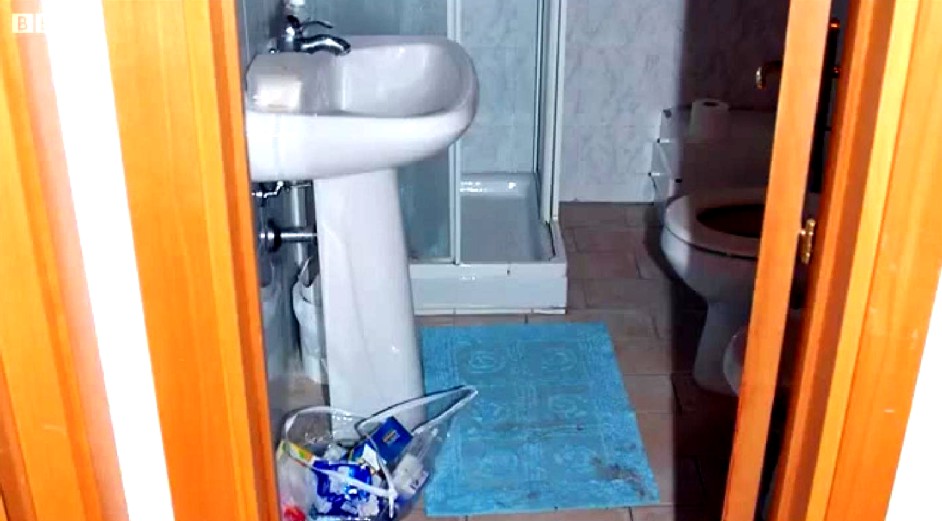
[Please click on each image for a larger and more high-resolution version]
The sheer depth and width of the hard evidence
The defenses really don’t want you to know this: in both width and depth, the full panoply of the evidence against Knox and Sollecito is absolutely overwhelming.
As we remarked in our post below there are far more and far stronger evidence points than UK and US courts normally require for conviction. But only the trial panel of judges observed anything like their full array.
The 2010 Massei Trial Report (which the Nencini Appeal court validated this past January) is a SUMMARY of what was presented to the judges in the courtroom. Those presentations in court were in turn something of a SUMMARY of the hard evidence buried in all the evidence files and the minds of witnesses.
Italian media SUMMARISED for Italians what was to be seen in the courtroom and to be read in the Massei Report. They were barely able to do even summaries for the 1/4 of all the trial hearings that were not open to the media or the public.
UK and US media for the most part didn’t even bother to provide comprehensive summaries (the very fine on-the-spot reportings of Andrea Vogt, Barbie Nadeau and Ann Wise were the main exceptions).
So in effect people in the UK and US attempting to follow the story didnt for the most part receive even a summary of a summary of a summary!
Not one US or UK newspaper or TV network translated the Micheli Report, or the vital Massei Report, or the Supreme Court appeal, or the Supreme Court outcome - only the (mostly professional) translators on PMF dot Org did all that translation.
This post is another example of how far down - beyond even Massei - it’s possible to drill into the evidence, and see it still hold up.
Some past posts on TJMK drilled down to similar depths, on the knives, on the DNA, on the mixed-blood traces, on the phone-events, on the motives and psychologies, and so on. All that evidence too all held up.
Visual analysis of the bathroom-mat footprint
This post mainly consists of high-resolution pictures and measurements. Presented like this, the pictures and measurements largely speak for themselves, and show the real strength of the bathroom-mat footprint evidence.
You will see that as SomeAlibi previously concluded using other methods, this footprint was quite undeniably Sollecito’s. It bears no similarity at all to Rudy Guede’s.
Please click on all images for larger versions in scalable PDF format
1 . [Below] the bathmat and the print, with measurement reference
2 . The bathmat print and the surrounding area
3 . The bathmat print (photo from Polizia Scientifica).
4 . The bathmat print, with vertical and horizontal sizes, from Rinaldi’s report
5. The bathmat print, photo with enhanced contrast.
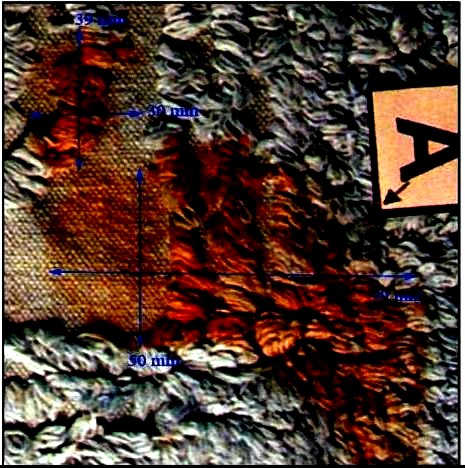
The photo above was modified by highly enhancing contrast.
6 . Enhanced contrast helps to spot some features
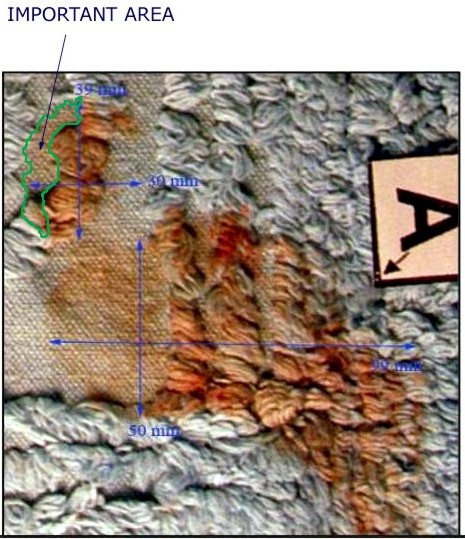
Contrast may help to highlight especially some parts of the print outline.
For example the area on the left labeled as “important area” in the picture (which was “forgotten” in the notorious photo elaborations disseminated by the ‘Friends of Amanda’ group), shows the actual left outline of the “˜big toe’ of the bathmat print.
The toe includes the area indicated in this picture (here the picture is shown again in its original colours).
7. The bathmat, with enhanced contrast
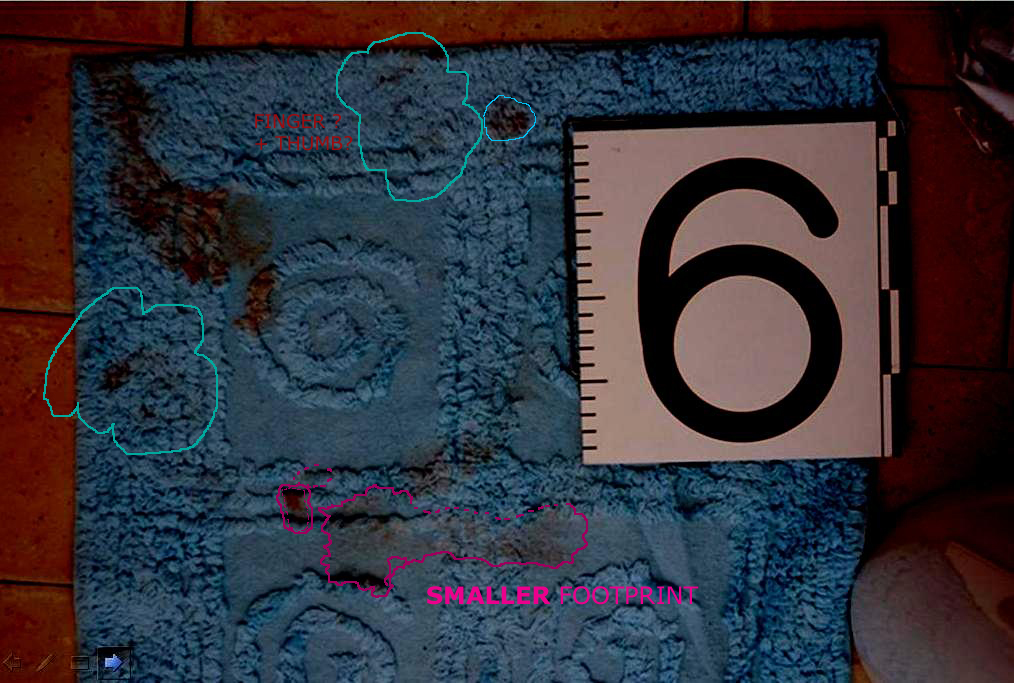
The contrasted image is showing the presence of other stains
There are other stains on the carpet (about another 10, factually situated in one half of the mat area), and also there shows a second diluted footprint (apparently from a foot of smaller size).
8. The selection of a set of red colour shades, outlined by an automatic outline generator
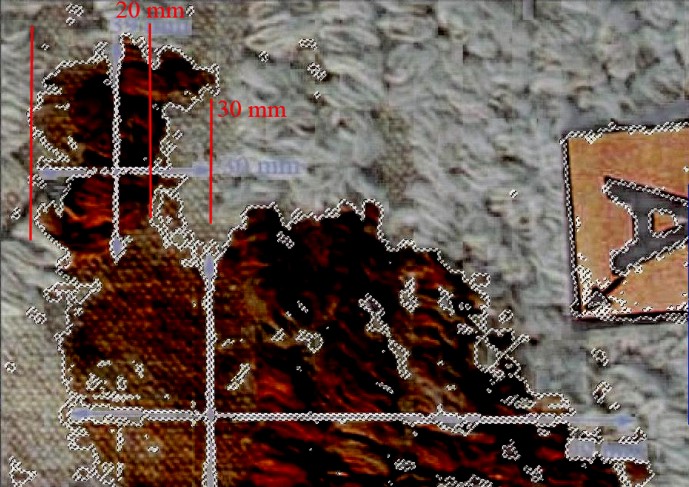
Shows the shape and the possible “˜outline’ of the stain
Reference measurements indicate the width of the “˜big toe’ in millimetres.
9 . A hand drawing of the outline (detail).
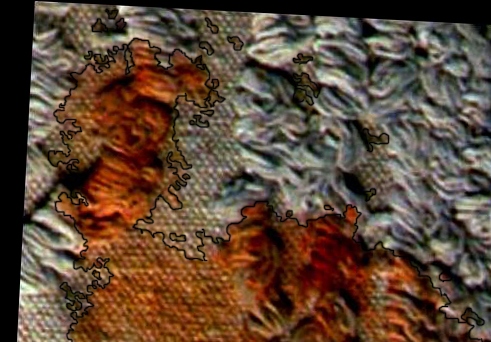
The photography above was modified
The modifications are: +28% contrast, -8% luminosity, + 20% colour saturation, from the original.
An outline has been drawn manually on the photoshop image, trying to be as faithful as possible to the actual stain.
You can notice that, apart from some minor “˜disputable’ very faint areas (such as the area between the toe and the metatarsus) there are only minimal differences between an automatically generated outline and a manually drawn one.
The shapes of the “˜big toe’ are extremely similar in both contours (images 8 and 9), in fact all meaningful features are basically identical.
We consider this manually drawn outline as good for comparison.
10 . The complete hand-drawn outline
11 . Minor detail: small dots separated from the main stain
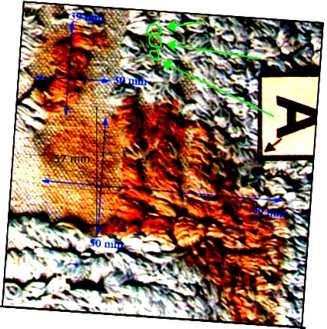
Observe the small red ‘dots’ in the picture above
Although we can’t draw any conclusion about their possible significance, we note the existence of these very small “˜spots’ of a faint red colour shade, separated from the big stain.
They are detected by the computer generated outline above, and that we also see as distinguishable with the naked eye thus we considered them in drawing manually the outline.
We don’t draw any conclusion about them; but because of their sensitive position (they may suggest a “˜small toe’ mark) we take note of them.
The green arrows in the picture point out their position (green circles).
12 . An image in electronically modified colours
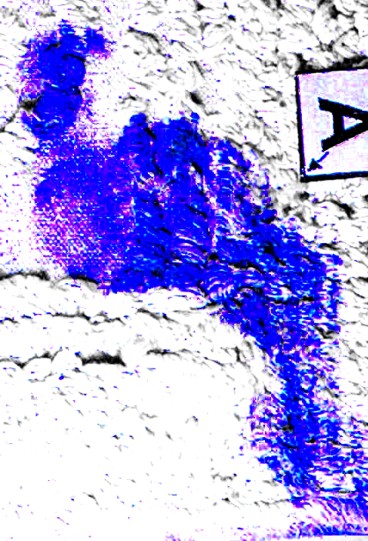
Distribution and intensity of the colouration
As a part of the preliminary study of the stain, we also produced this image above where the computer assigned an artificial colour to an array of shades of ‘red’, thus allowing to further isolate the stain from the background for further assessments about its shape.
This picture shows the distribution and intensity of the colouration. (note: the existence of some above mentioned tiny marks is recorded by this technique too)
13 . The bathmat has a spiral-shaped relief decoration
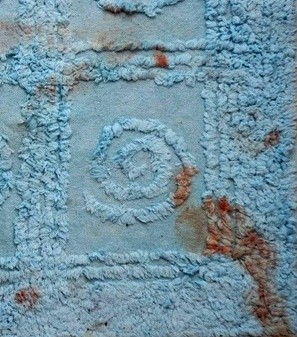
The footprint’s toe obviously balancing on top of the relief decoration.
We think the outline of the “˜toe’ mark of the bloody footprint is affected by the shape of the decoration, in particular the missing part of the toe on the right side, which is remarkably coincident with the margin of the decoration.
So that on that side there is a striking correspondence between the outline of the “˜negative area’ ““ the fabric surface around the spiral, which is lower ““ and the big toe’s outline
This indicates that the outline of that mark on that side was affected by the decoration margin, thus the print there has a “˜missing part’. So the “˜crooked’ bloody area in fact follows the margin of a larger toe.
Because of such coincidence, we can logically assume that the actual shape of the big toe mark appears to be part of a big toe, with larger surface which left its print only partly because part of its surface did not have contact with the fabric, in correspondence of the “˜negative area’.
14. The “negative area”
15. Mat decoration in relief and the toe mark
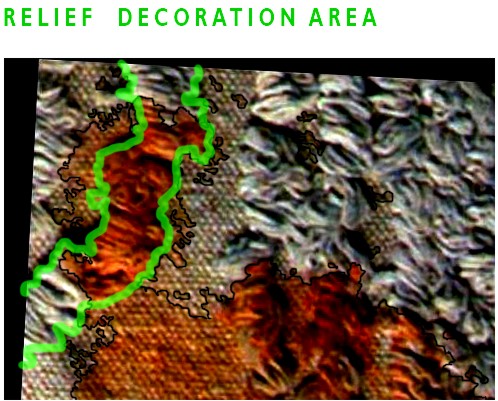
Observe above one single, unitary stain
The remarkable coincidence between the outlines of the decoration in relief and of the toe mark is shown in the picture above.
The rough contour of the print obtained through a smooth curve highlights the shape of the big toe.
Part of the relief decoration outline coincides with the toe mark outline, which shows, highlights and explains how all parts of the red toe mark, that you can see left of the relief decoration, they all belong to one single, unitary stain.
Thus we can deduce that the “missing” area on the right of the toe is determined by the decoration, and coincides with the negative area.
16. Picture (by Kermit) showing a rough shape of the stain
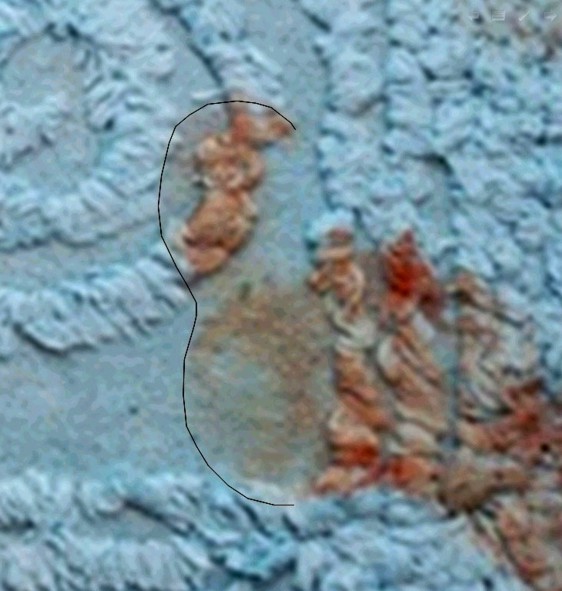
Observe shape, curvature and size
This drawing by Kermit above highlights the rough shape, curvature of left margin and overall size of the big toe.
17. Rudy Guede’s sample print
A copy of this picture together with one of Sollecito’s print at the same scale will be used for comparisons.
18 . Raffaele Sollecito’s sample print
A copy of this picture together with one of Guede’s print at the same scale will be used for comparisons.
19. Part of Rudy Guede’s sample print with Rinaldi’s reference measurements
20. Part of Sollecito’s sample print, with Rinaldi’s reference measurements:
21. Bringing all photographs down to the same scale
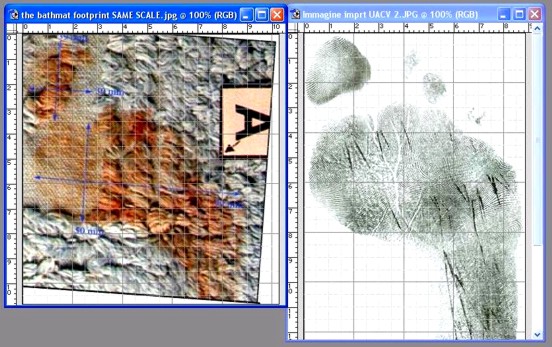
An accurate exercise of scaling was done
This was based on Rinaldi’s referenced pictures. Each one of the Rinaldi’s sample pictures has multiple measurements on several points of reference which allow a high precision determination of their scale and sizes, and thus comparison at the same scale.
In order to further increase scaling precision, the scale was calculated previously and separately for each comparative measurement in the three photos; this was done multiple times for each measurement and the average was picked in order to reduce error as for statistical measurement method.
The resulting final error in the scale is extremely small, far below a threshold of significance that could affect comparison (which was set arbitrarily at 1%, but it’s probably significantly higher, while the actual error is much lower).
In other words, the scale error that may affect your screen pictures will be definitely smaller than any possible perceivable (either significant or tolerated) difference that would be noticed or that may affect the attribution of the stain, when this is compared to the sample.
22. The hand drawn outline is shown again here
23 . The outline (matched scale) overlapped on Sollecito’s sample footprint
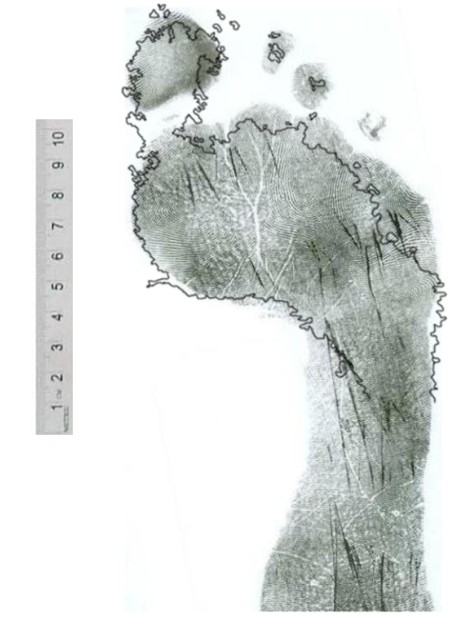
The array of compatibilities with Sollecito
The bathmat stain does not seem to have major incompatibilities with Sollecito’s print; it shows rather an array of compatibilities that can be perceived visually.
One interesting feature is the shape, size and position of a ‘big toe’, that appears as a remarkable coincidence; the toe also has a kind of cleft (see 28 below) on the curvature of its left margin. Another outstanding coincidence is the curvature of the plantar arch on the left.
24 . The same outline overlapped on Guede’s footprint
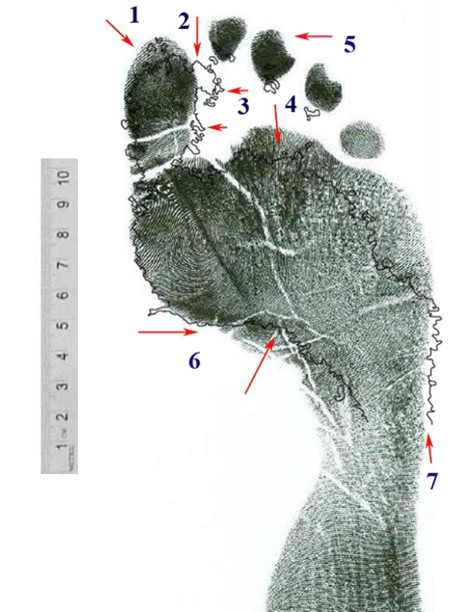
Compare with Guede’s - matched scale.
If you look at the overlapping of the stain outline (see pic 22.) with the sample of Guede’s print (see pics 17. 19.), you may notice 7 major differences, showing a failure of compatibility. Those differences are indicated by numbers (1-7) in the picture .
Each one indicates an area of major difference between the outline of the bathmat stain and the outline of Guede’s sample print. Those measurement differences are remarkably larger than those that can be detected on the overlapping with Sollecito’s sample print.
On the other hand, the compatibility between Sollecito’s print and some very peculiar aspects of the bathmat print (such as a 30mm wide and short toe) were absolutely remarkable.
The differences between the bathmat stain and Guede’s print are :
1) Toe mark of stain is significantly SHORTER than the big toe in Guede’s sample print (a difference of about 7 millimetres). Some people may want to attempt an objection, by suggesting that such a difference may be just a consequence of the position chosen for the overlapping, that maybe the bathmat print was just positioned too low in the picture, the problem may be solved by shifting it up about 7 millimeters so as to make the tip of the bathmat toe ‘coincide’ with the tip of Guede’s print toe.
However, such objection wouldn’t work; it’s a wrong argument. In fact the only possibly correct position for overlapping the bathmat stain outline is determined by the left curvature of the ball of feet and plantar arch (the area of the picture near number 6), which is by the way the most clearly outlined part of the bathmat stain. If you shift the bathmat stain upwards, the outline will miss the match with the curvature of the left margin of the ball of the feet. You will notice that the plantar arch in this area is already very incompatible with Guede’s plantar arch. It tends to become even more incompatible the more you shift the bathmat stain outline towards the toe.
The problem has no solution, since the more you shift the stain outline upwards (in the direction of the toe) in an attempt to make it look more ‘compatible’ with the length of Guede’s toe (or with an upper margin) the more it will become incompatible with the plantar arch. In order to limit the incompatibility of the plantar arch, and in order to keep an overlapping of at least the left margin of the ball of the feet, you need to place it as shown in the picture, this is the position of ‘maximum’ compatibility between the bathmat stain and Guede’s print. Conclusion: the bathmat toe is too short.
2) Toe mark of stain is TOO WIDE (30 mm). It is much wider (30 mm) than Guede’s toe. The number 2. indicates the protruding mark at the upper right, the mark which Giulia Bongiorno desperately insisted on calling a “second toe” mark. In fact, not only would the mark miss completely any hypothetical Guede’s ‘second toe’ in any possible position of the print; also you may notice (highlighted by pics 8. and 9.) how it is not a “mark” itself, but actually it just part of the same area which is entirely continuous in shape and coloration with the rest of the toe mark, and - the most remarkable feature - its right outline is coincident with the outline of the spiral-shaped relief decoration, so that you can reasonably conclude that it is determined by that (the missing area at the lower right of the ‘big toe’ is determined by the existence of the “negative area” of the bathmat decoration).
Conclusion: the bathmat stain has a wider toe mark, however one likes to call it (“big toe”, or “big toe + second toe”) that fails to match any possible part of Guede’s print. The bathmat print is clearly different and incompatible with Guede’s print. It simply cannot be overlapped to any part of Guede’s sample print. Such area is a very significant difference that points outright to incompatibility between the stain and Guede’s print.
3) The toe mark is larger also in the area located at the lower portion of the toe. The toe of the bathmat print in fact has a ‘right margin’ which actually has some additional small marks, small drops protruding towards the right, like droplets maybe produced by the wet cotton fibres of the part in relief which protrude towards the right. This tends to suggest the toe area of the stain may in fact be considered wider: the object that produced it was definitely wider than 22mm, in this area of the toe as well. So also a look at this area confirms that the bathmat stain is wider than 22-23 mm (more towards 30 mm) not just when measured at the upper corner (number 2.) but also at its “lower” parts; here, the small marks caused by the liquid suggest that a larger surface has squeezed liquid from some fabric threads leaving some trace also on the lower area.
4) Bigger incompatibility of Guede on the metatarsus front outline. This area is the front outline of metatarsus: the stain is almost 1cm shorter than Guede’s metatarsus. This happens when you chose the overlapping so as to make the left outline and plantar arch (6.) of metatarsus coincide, as in the picture. Sollecito’s sample print also shows some difference from the stain in this area (pic. 23.) but the difference between the stain and Sollecito’s print is significantly smaller than what you can see in Guede’s print.
5) There are NO SMALL TOES in the bathmat stain. Small toes are completely absent from the bathmat stain (while the tiny blood marks around the stain don’t coincide with their expected position if it was Guede’s print). Such lack of small toes is a peculiarity of the bathmat print. This is a remarkable difference from Guede’s print, and at the same time, a considerable analogy with Sollecito’s print. In fact one outstanding feature of Guede’s print is the evidence that Guede places a big load of weight on his small toes while instead Sollecito has a posture with a weight distribution with the contrary tendency, and obviously he almost does not touch the ground with his small toes.
Thus, Guede’s small toes are all very well pressed on the ground and thus, we can reasonably infer they are somehow naturally likely to get wet if he steps on any wet surface, and anyway they should get wet for sure if the foot is immersed in water or washed (the foot that left the bathmat print must have been immersed in bloody water). The murderer supposedly washed his foot then stepped on the bathmat. In order to attribute the print to Guede we should assume that Guede “forgot” to touch the carpet with his small toes (while instead he puts a lot of weight on them) or that he managed to not rinse them.
6) The outline of the stain has a PLANTAR ARCH that COINCIDES, by curvature and angle, with the plantar arch in Sollecito’s print, while instead it is very different from the plantar arch of Guede’s print.
7) The stain is larger than Guede’s print metatarsus as visible in the right area of the stain. The difference is rather significant, almost half a centimetre, that is bigger than the difference with Sollecito’s print which instead coincides for a trait. This difference cannot be “solved” in any way since, even if one wanted to claim that the scale is wrong and that the stain should be sized down, this would make the toe, already too short (as in 1.) become even shorter.
If instead the toe length is adjusted the metatarsus becomes even less compatible with Guede. We recall that Massei found that Guede’s feet had a print overall more slender than Sollecito’s.
25 . Other features:
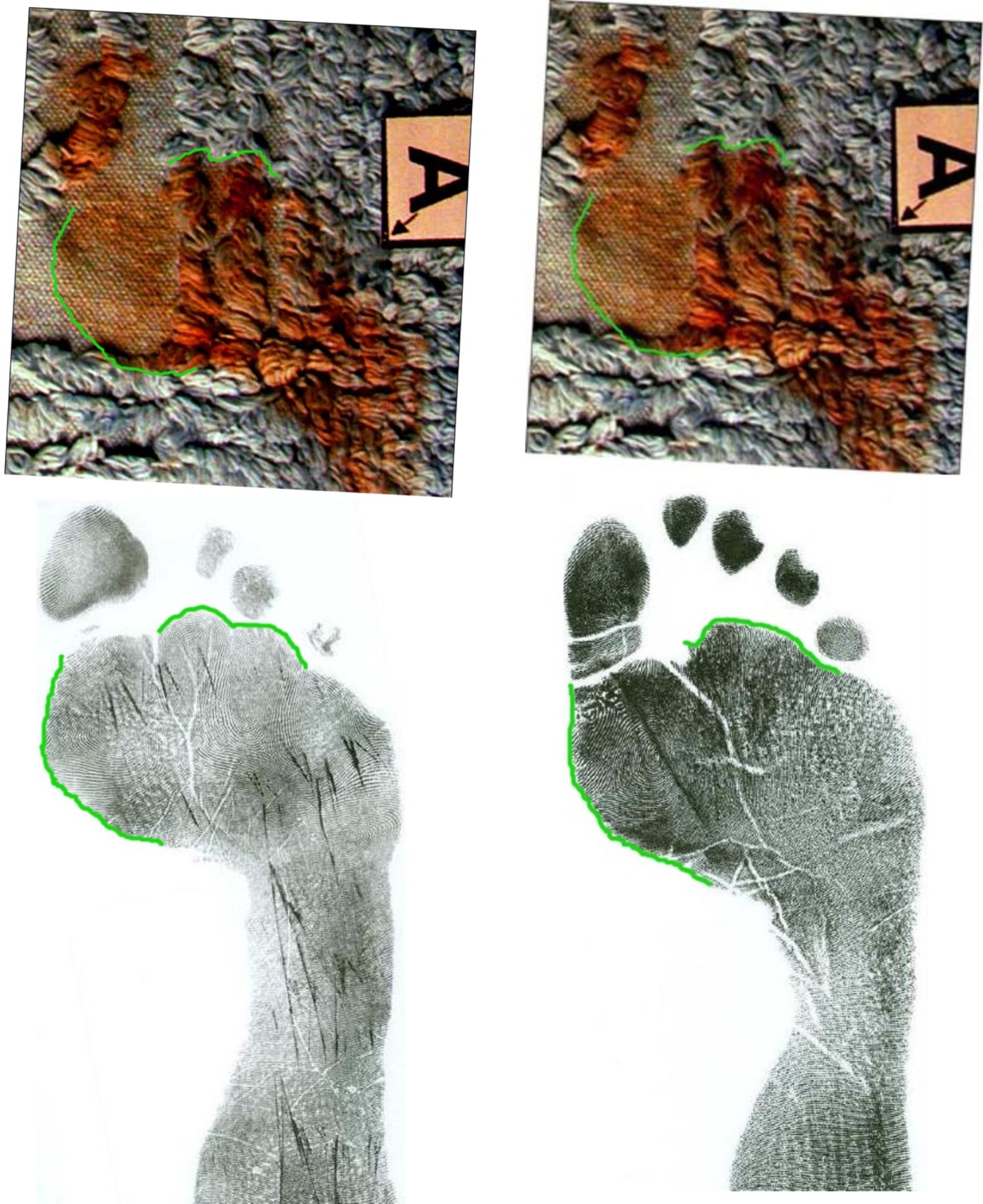
Curvatures of plantar arch are very different
The plantar arch curvature, highlighted in two different drawings (the second highlights also the upper outline “hunches”); the plantar arches in the two sample prints of Sollecito and Guede are shown below. The curvatures of plantar arch are very different.
26. The outline curvature generates different angles
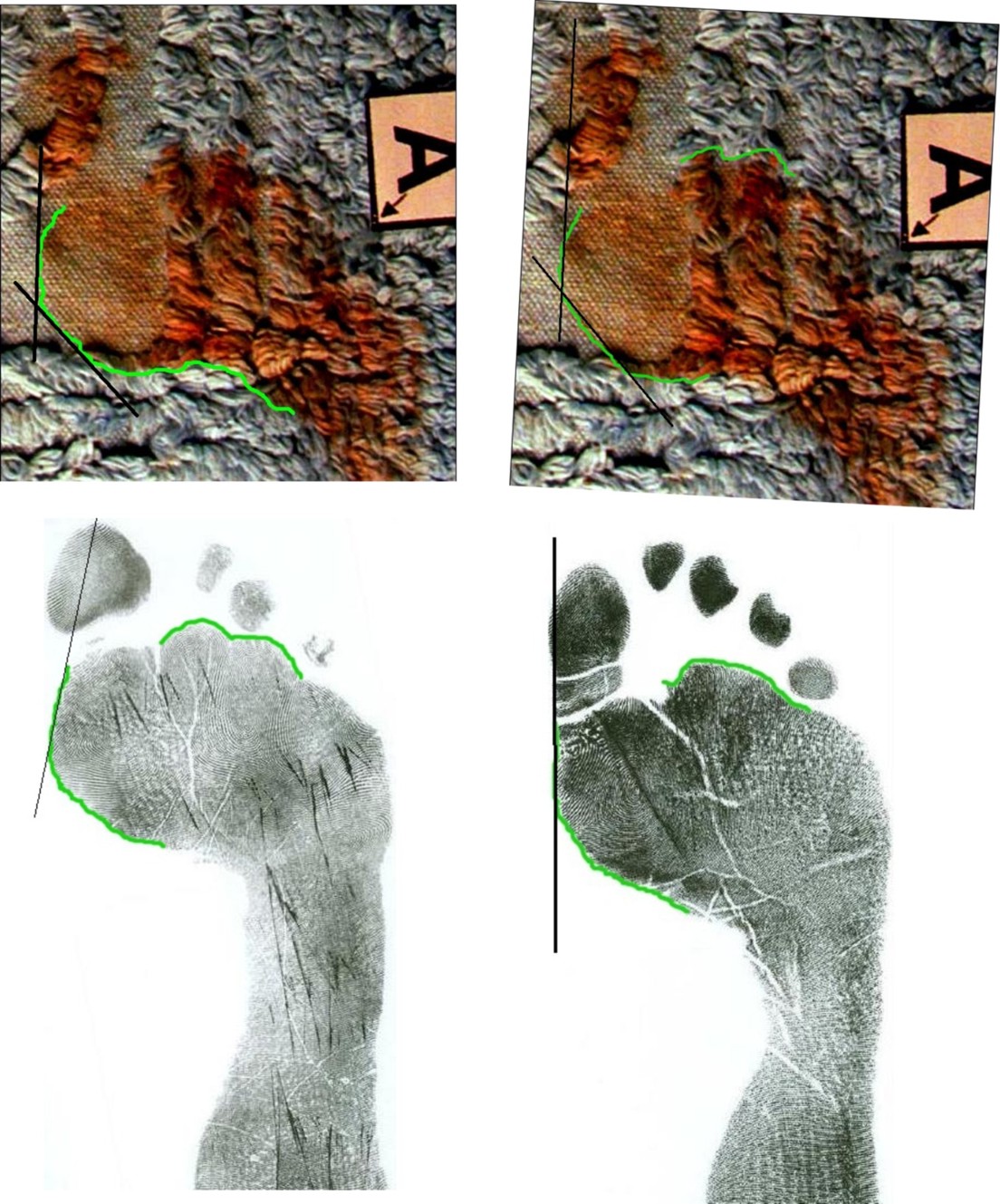
Sollecito’s and Guede’s plantar arch curvatures have very different angles. Also the left outline of metatarsus maintains a different curvature. Sollecito’s outline has an angle (see outline tangent) intersecting the toe (the metatarsus has a “bunion”); in Guede’s print there is basically no intersection, the outline and the toe form almost a straight line.
27 . Plantar arch curvature angle differs between Sollecito and Guede
If you consider the vertical axis of the sample footprint, and its orthogonal line, you may notice how the plantar arch curvatures of the two prints accomplish different angles: the two angles are VERY different, not just three or four degrees.
The (too) narrow angle of Sollecito’s plantar arch probably has a relation with the protruding outline and angle seen in pic 26., and seems related to a hallux valgus (which Guede does not have).
28 . The “cleft” on the left side of the stain
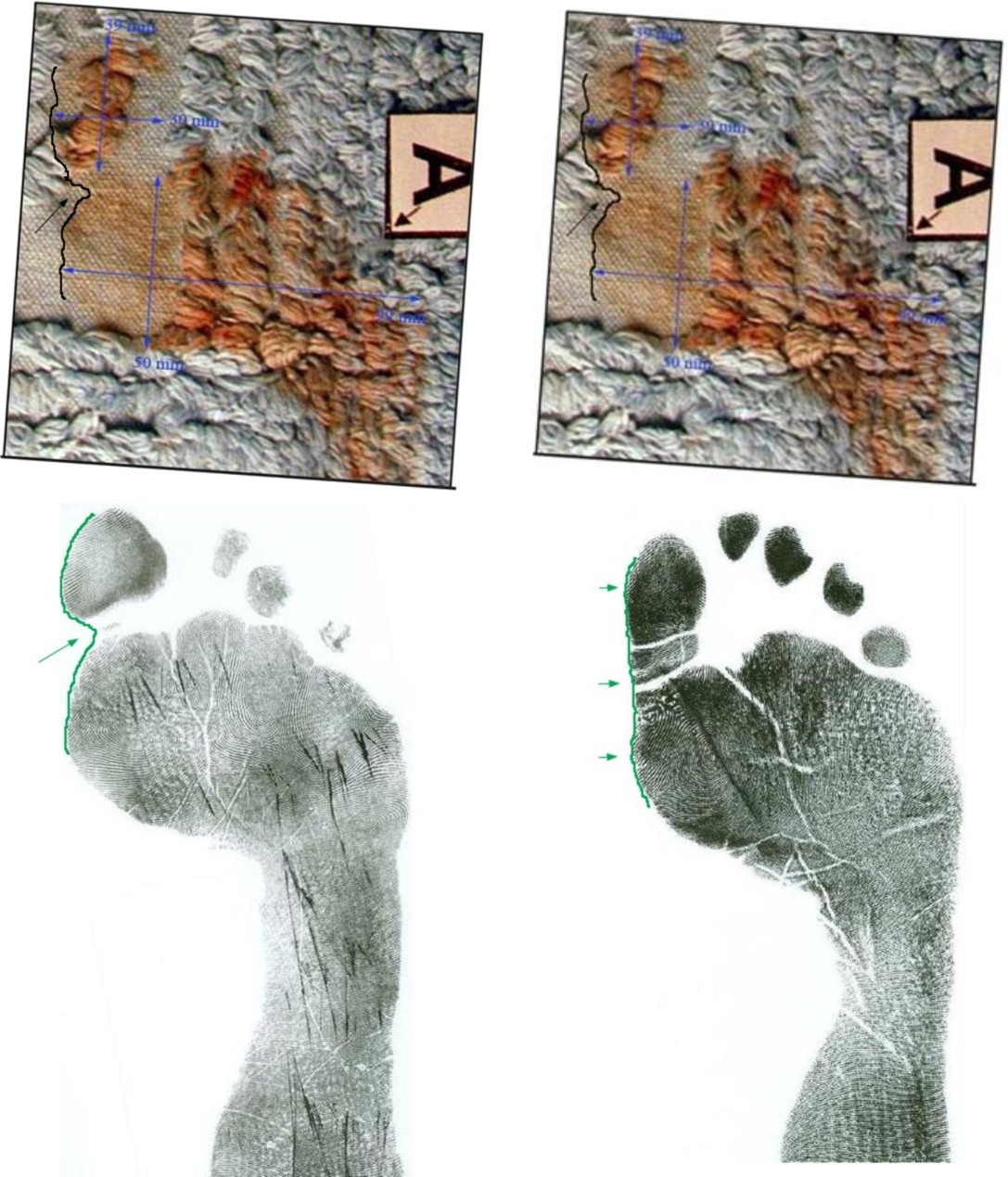
The “cleft” on the left side
This has a correspondence with one sample print, not so with the other.
29 . Table of metric comparison (by SomeAlibi)
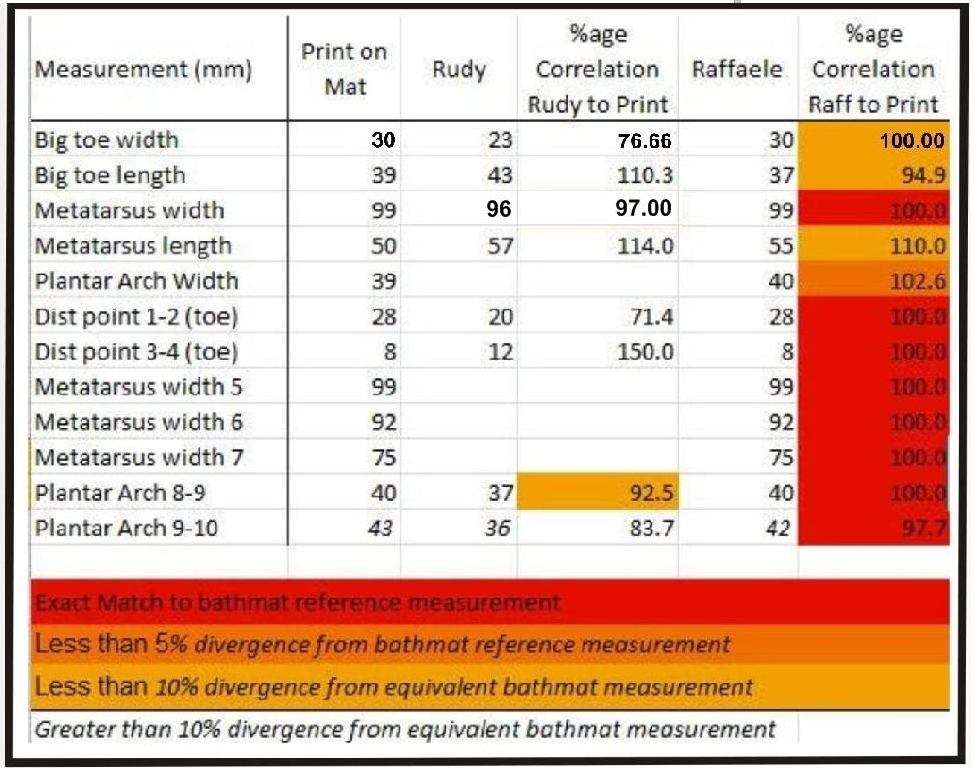
SomeAlibi’s post of a year ago
Comparison of measurements and analysis of correspondence degree of bathmat print, with both Guede’s and Sollecito’s sample prints.
Monday, March 03, 2014
As Knox & Sollecito Try To Separate Themselves, Each Is Digging The Other In Deeper
Posted by willsavive
1. Sollecito Blabs Yet Again
One of an increasingly long list of “gotchas” for the prosecution, flowing from their tendencies to talk way, way too much.
In a recent exclusive interview on an Italian TV news broadcast, Sollecito said he has several “unanswered questions” for his former girlfriend, Amanda Knox.
“You all know that the focus was only through Amanda to her behavior, to her peculiar behaviour, but whatever it is, I’m not guilty for it. “Why do they convict me? Why do put me on the corner and say that I’m guilty just because in their minds I have to be guilty because I was her boyfriend. It doesn’t make any sense to me.”
This adds yet another waiver to the many different explanations Sollecito provided over the years about the same details.
In their “official” story, in the part that remained consistent, Knox and Sollecito both claimed that Knox left his flat the morning after Kercher’s murder and returned home, where she noticed the door left wide open and witnessed blood spots in the bathroom.
Knox claimed that she found it odd and just assumed that one of her roommates was menstruating and left blood behind. She proceeded to take a shower and returned to Sollecito’s flat and ate breakfast.
2. Telling Narrative Change
“Certainly I asked her questions,” Sollecito explained in his latest interview. “Why did she take a shower? Why did she spend so much time there?” When asked what responses he had for these question Sollecito replied, “I don’t have answers.”
In the interview, Sollecito said Knox left his apartment to take a shower, then returned hours later looking “very agitated.”
Yet, in an interview with Kate Mansey on 4 November 2007 just two days after the murder, and two days prior to arrest, Sollecito said:
But when she went into the bathroom she saw spots of blood all over the bath and sink. That’s when she started getting really afraid and ran back to my place because she didn’t want to go into the house alone.
3. RS Differs Sharply From Knox
This is a far cry from what Knox said in her email also dated 4 November 2007 to friends and family, Knox wrote:
I returned to raffael’s place. after we had used the mop to clean up the kitchen i told raffael about what i had seen in the house over breakfast. the strange blood in the bathroom, the door wide open, the shit left in the toilet. he suggested i call one of my roommates, so I called filomena.” (6th paragraph).
The discrepancies between Knox’s version and Sollecito’s version is strikingly different.
- Raffele claims Knox was visibly distraught when she returned and that this was the focus of discussion (i.e. being the first thing they discussed).
- Knox claims that she did not even bring up the bizarre circumstances back at her apartment until “after” they finished mopping the kitchen floor.
4. My Analysis Of The Above
In his latest statement, Sollecito is clearly trying to distance himself from Knox, believing that there is far more evidence against her than against him. But:
- Sollecito forgets to mention the bloody barefoot prints at Knox’s apartment, found to be in Kercher’s blood attributed to him.
- Also the knife found in his apartment that scientists say was the murder weapon.
- Also his DNA found on Meredith Kercher’s bra that was found in her room, even though Sollecito claims that he was never ever in that room.
- Also his own strange behavior, which includes providing a false alibi (saying he and Knox were at a party with a friend on the night of the murder).
Also several conflicting other versions.
But what’s there to question if you [Raffaele] were with Knox the whole day and night of Meredith Kercher’s murder?
It appears as though Sollecito is alluding to the notion that he knows something far more than he is saying; yet, he is being very careful with his words””only providing us with a hint of this.
His latest statement is a clear attempt to distance himself from Knox.
5. Sollecito Freaks Out On Twitter
Sollecito appeared on Twitter recently, for what he claimed was to answer questions and clear his name.
He was very outspoken of his innocence and had no problem in his witty, sarcastic responses to those who questioned his innocence.
However, when I asked him about the Mansey interview he denied claiming that he was with Knox at a friend’s party on the night of the murder [huh?!].
Sollecito disappeared for a couple of days, came back to Twitter writing only in Italian, and ceased responding to any more questions.
Is it possible that Sollecito will turn on Knox altogether at some point when the pressure mounts over the next year? Guess we’ll have to wait and see”¦
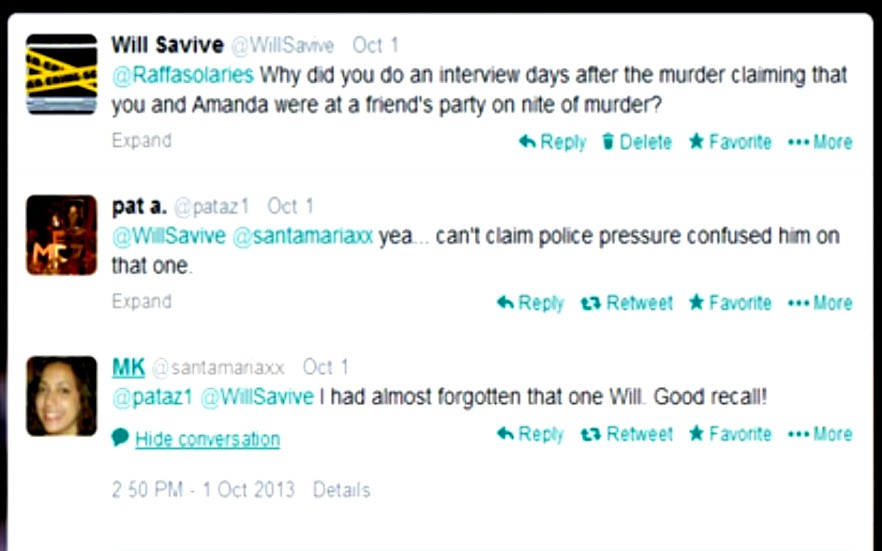
Cross-posted from Savive’s Corner
Wednesday, February 19, 2014
Our Reviews Of The Painstaking BBC-3 Report First Aired In The UK On 17 February 2014
Posted by Our Main Posters
Review by SomeAlibi
Watching “Is Amanda Knox Guilty” was a funny thing. I suspect for people following the case closely, on either side, it was a sobering experience. Not because it changed perspectives, but simply to see how quickly one hour passed and the necessary trade offs that had to be made to fit within that schedule. The opportunity cost was a level of detail to which in-depth followers have become accustomed.
Just one example: Sollecito and Knox’s partial alibi that they were checking their emails on the night of November 1st was explained as being challenged by two broken computers. Perhaps, (although unlikely to be the material issue) but where was the much more salient fact that their ISP records showed that was conclusively untrue? Where was the challenge: if you say you’re checking emails to establish part of your alibi against a murder and it is shown to be absolutely untrue, what does that suggest…?
There were many other “clinchers” that had to be let go in the name of brevity. But it wasn’t that sort of documentary - it was neither a case for the prosecution or a case for the defence: it put the main suggestions at the level of detail that was possible and it allowed both sides to speak to the points at that level of detail.
I find it interesting that there has been such a howl of bias from those supporting Knox and Sollecito. Objectively there’s no good ground for it: the documentary allowed both sides forward in equal measure and no pro-justice watcher would celebrate it as a pro-conviction piece.
The arguments were balanced, the video, audio and picture quality eye-opening. For those on the other side, their markedly different reaction appears to be that the documentary has broken the taboo that The Evidence Shall Not be Told. The idea that there is an easy-to-consume piece that puts forth the case and defence equally is seen as a disaster.
The campaign for Knox continues to be obsessed, beyond all things, with trying but now failing to make sure the public doesn’t know the basis of the case. For a long time they hoped to drown out the multitude of terribly inconvenient truths within it by screaming “no evidence”. ‘Is Amanda Knox Guilty’ put the lie to that conclusively, but fairly, and now many hundreds of thousands, perhaps soon to be millions will ask themselves why those supporting Knox and Sollecito have had to adopt this tactic at all.
If they really are innocent, why has the case against them been so comprehensively white-washed in the US?
The conclusion, is rather simple and I saw it encapsulated on a large television screen last night with the repeated clips of Amanda Knox and Raffaele Sollecito outside the cottage kissing and “comforting” each other: there for a fraction of a second, shown several times, is Amanda Knox, unable to stop herself glancing at the camera filming her and stealing her gaze away again very quickly pretending she hasn’t.
It’s a look that says everything: furtive, pretending it didn’t happen, immediately covering up in a way that poses a stark proposition: why on earth would you do that if you had nothing to hide? And like so much of the multiple collapsing alibis and non-working answers and the desperately dishonest fingers-in-the-ear “no-evidence” pretence of those supporting her, is a proposition that can withstand no scrutiny.
Review by SeekingUnderstanding
What a relief to watch a very clear and unbiased narrative. The quality of the visual information was top rate - seeing so much original footage, and presented as it was in a logical time sequence.
Even though I was already familiar with the evidence, including the photographic material, I found it very helpful to see it all presented in this way. I appreciated, too, hearing and seeing the excerpts in original Italian (along with English translations). It added even more authenticity.
I hope that, at long last, this will have helped some - or hopefully many- people to see that the two ‘camps’ in this case do not divide into AK supporters and AK ‘haters’. There are the FoA and their followers ...and there are the others who seek the objective truth and justice.
If hate has been generated in some quarters, then the Knox (and Sollecito) camps need to look to themselves and their own behaviour. This programme was important in the tone it set.
I actually found it to be quite lenient towards the defence on a number of counts.
There were several instances where the defence point of view could have been strongly countered by known and established facts, but, bending over in fairness, these were left unanswered.
Here are just four instances :
1) In the discussion around the blood and DNA left in the bathroom - Dr. Gino’s assertion that ‘the blood/DNA ‘could have come from anywhere’ might have been countered with AK’s own declaration that the bathroom was previously clean. Dr. Gino also suggested a very improbable scenario of ‘it could be saliva’ (on the bidet?). Cassation emphatically said that it must be shown HOW any suggested contamination could have occurred.
2) There was a missed opportunity in discussing the knife presumed to be the murder weapon to mention Sollecito’s lame, unreal excuse of ‘Meredith pricked her hand’ etc.
3) Anne Bremner stated ‘Amanda could not have turned overnight…into a murderer’. Attention could have been drawn to many things, both physical events (her predilection for cruel pranks, including a staged burglary in the US, and wild parties, etc), and also many psychological indicators that would have clearly shown how her behaviour has, in fact, demonstrated consistency.
4) In the discussion re the bra clasp, the delay partially being caused by the defence themselves was not mentioned. Also, detailed discussion re the one bare footprint on the bathmat was omitted.
Since there is, in fact, so much evidence, it must have been difficult to chose and balance what did go into the hour long programme. All in all, I feel Andrea Vogt and her team worked hard, and did very well to let the facts speak for themselves.
I hope it will lay a few fictions and myths to rest.
Review by Earthling
What is the “Amanda Knox trial” (really the Meredith Kercher murder trial) really about? Is it about an innocent 20-year-old pretty white girl being railroaded by the medieval Italian justice system?
Or is this actually a murder trial, about the fact that a beautiful, intelligent, ambitious young woman, innocently trying to improve her life by study abroad, was brutally murdered?
I believe it’s the latter, and the BBC3 production gives us one of the first truly balanced reports on this trial.
The filmmaker starts from the beginning, and takes us through the murder, investigation, and various trials and appeals up to the present day. Instead of the breathless “Perils of Penelope” tone (toward Amanda Knox) that most such previous “documentaries” have taken, this one takes a sober look at the actual evidence.
Did you realize that there are luminol-revealed bare footprints in Knox’s size in the apartment? Luminol reveals blood and a few other substances; but those substances can be ruled out because the test was done six weeks after the murder, by which time those substances would have dissipated.
Blood doesn’t dissipate. This documentary shows you those bloody footprints in all their creepy glory, something never shown on American TV before.
“Is Amanda Knox Guilty” also speaks of the actual DNA evidence in the cottage linking Knox to the murder, including five mixed-DNA spots (Knox and Kercher) that tested positive for blood. Both prosecution- and defense-oriented experts are allowed to comment on this evidence, and the viewer is allowed to make up his or her own mind.
My one criticism is that a lot of the evidence against Knox (witness statements, cell phone data, fake break-in) is skimmed over or not even mentioned. Also, because the documentary quotes Rudy Guede’s position at length without any contradictory narrative, it is confusing as to whether the filmmaker might have believed him.
In the end, the filmmaker says, he was convicted of participating in the group murder. However, a stronger statement against his “I’m entirely innocent” defense would have been good.
Other than these quibbles, this is the best documentary on the Meredith Kercher murder case that I have ever seen.
Review by ZiaK
I watched the BBC programme on the Meredith Kercher case hoping for a more balanced view of the case than has been presented in the English-speaking media to date.
The documentary does present some of the evidence against Knox and Sollecito - including the bloody footprints, the mixed blood/DNA traces in the bathroom and corridor, the bra clasp, the knife DNA evidence, the strange timings of phone calls to police, the unlikelihood of the “break-in” being anything other than staged - but omits to point out that none of the other flatmates’ DNA was found in the blood traces, so saying that “it’s because Meredith and Amanda shared a flat” is misleading.
Nor does it point out that, although the murder knife was found in Sollecito’s flat, none of HIS DNA was found on it: it had only Amanda’s and Meredith’s DNA.
The programme didn’t cover the cell-phone evidence, showing that neither Knox nor Sollecito were where they said they were, at the times that they claimed. The programme also repeated the “Friends of Amanda” PR soundbites, such as “there was no evidence of Amanda in the murder room” - whereas the fact that her footsteps tracked blood OUT of the room are actually evidence of her having been present IN the room before it was locked (i.e. at the time of the murder).
Furthermore, in my opinion, the narrator’s voice seemed to evince sympathy towards Amanda, rather than describing events with a passive or objective tone of voice.
As one of the translators who has participated in translating case documents (such as the judges’ reports describing why they came to their decisions), I am only too aware of the extent of evidence against Knox and Sollecito, and I would like to see knowledge of this evidence become more widespread throughout the English-speaking world.
The BBC programme is a step towards this, but in my mind, only a very small step. I hope the pace will pick up soon, and more objective and extensive knowledge of the true facts of this case will be made available to everyone so they can form a rational opinion of the case based on true understanding.
Review by Cynthia
I’ve just watched this, and it’s very good - with a huge amount of footage hitherto unseen (directed by Andrea Vogt).
For what it’s worth, I note the following points:
1) There’s no mention of Meredith’s friends who heard Amanda say ‘she fucking bled to death’ before the fact was known to anyone else. Perhaps they didn’t testify, being too distressed? If so, it’s a great pity, because it seems a veritable clincher that hasn’t been used at all.
2) The bra DNA arguments are quite extraordinary. If we can determine that we all have Neanderthal DNA (tho’ I know a lot of American fundamentalists don’t believe that mankind goes back more than 6,000 years!) I can’t for the life of me see why DNA would be unusable after a poxy delay of 12 days ...
3) The argument that the Luminol traces may indicate not barefoot treading in blood but in bleach seems absolutely unbelievable to anyone who does housework (like me!) Bleach is horrible stuff, and you really, really don’t want to be getting it on your bare skin. Even Amanda, with her vestigial domestic skills, would have noticed if she’d trodden in it.
4) Bremner says Amanda was an honor student. She wasn’t; she had funded herself (not that that’s discreditable). (Also, are honor students unable to write cursive script? The shots of her handwriting show that she can’t do joined-up writing. [Or thinking.] I don’t know whether the phrase exists in American English, but not doing joined-up writing is a term of great intellectual contempt in English.)
5) We saw Amanda’s ‘mask’ speech. This is really interesting - who would even think that masks were being put on them if they weren’t using them themselves?
6) The programme mentions the little-reported fact that another, smaller knife found at Sollecito’s also had Meredith’s DNA on it.
7) The film omits to mention Hellman’s lack of any experience in criminal trials.
8) Every shot of Amanda in the film has her talking about ‘me’ and ‘I’. She never, ever mentions Meredith - it’s all about HER suffering. She never even says ‘the murderer is out there - I wish you’d stop persecuting me and get them’.
Presumably this is because Guede is supposed to be the sole murderer - and nobody seems in the slightest bit worried that there’s no murder weapon with HIS DNA on it! (Yes, there are his turds - but that wasn’t what killed Meredith.)
9) FOA has used the fact that the recent jury took 12 hours to deliberate over the verdict as an indication that they couldn’t agree. But why not just that they were being extremely careful and re-examining everything?
10) Finally, just an observation: Maresca speaks the most beautiful Italian - you can hear every word calmly flowing past.
Review by Miriam
Much appreciated. Outside of the Porta a Porta transmissions on the case, the best I’ve seen.
I understand they had to give both sides, but I felt that the defense came out on the losing side. I thought it funny that it was implied that since they only tested for blood it could of been saliva.
I don’t believe even her supporters would argue that Knox was so quirky as to brush her teeth in the bidet! Or maybe she spit in the bidet, in which case Meredith would have had every reason to complain about her bathroom habits!
Now if only this or something like this would air in the U.S.
Review by Sara
This is actually one of the most objective and well-researched reports I have seen on the case and I am very happy that BBC has managed to be so unbiased.
It presents both sides of the story equally well and does an excellent job of countering the extremely silly “no evidence” argument that the FOAkers like to repeat at equal intervals.
Regardless of what one believes, I think the documentary will at least succeed in convincing most people that there is indeed sufficient evidence against the two of them, and Italy’s judicial system is not crazy to convict people without any evidence.
My favourite part was when the defense DNA expert (can’t recall her name) tried to explain away the mixed blood evidence by saying that one of them could have had a nose bleed, and the other could have cut her hand in the same place leading to mixed blood.
Come on already, what are we? Kindergartens making excuses for not handing in homework? What is the possibility that both of them would bleed in exactly the same places not once or twice but multiple times? I think anyone with a bit of sense can see that they are clutching at straws.
However, I was a bit disappointed that few things were missed out. For instance, the fact that Guede’s footprints led straight out of the house, the fact that Amanda’s lamp was found without any obvious reason in Meredith’s room, Amanda’s extremely odd midnight call to her mom that she conveniently “forgot”, her million showers despite her concern towards “water conservation” etc.
Sollecito’s multiple changing stories were not really elaborated upon (the story in which he went to a party, the one in which he checked emails, the one in which he pricked Meredith etc etc).
Also, inconsistencies between their accounts of various events could have been pointed out (Was Filomena’s door open or close? Did AK call Filomena from the cottage or from Sollecito’s house? etc).
Witness accounts were not given any screen space either. I think touching upon these would have made the documentary even more impressive.
That said, I understand that the team has done the best they would within the limited time they had, and everything just cannot be accommodated within one hour.
So, all in all, kudos to the team and BBC for a job well done.
Review by Odysseus
I though it was a very competent overview of the case. After so much pro-defendant spin in the MSM (no doubt engineered by the American defendant’s PR outfit), it was refreshing to have a sane, measured and rational presentation. The victim deserves no less.
Congratulations to BBC3 and to the programme makers. It’s good to know that the BBC of blessed memory hasn’t been entirely dumbed-down nor intimidated by “partial outside interests”, the latter being director Andrea Vogt’s own description of the forces intent on muddying the waters in this case.
Tuesday, February 18, 2014
Congratulations To The BBC For A Report Emphasizing The Sheer Extensiveness Of The Evidence
Posted by Our Main Posters
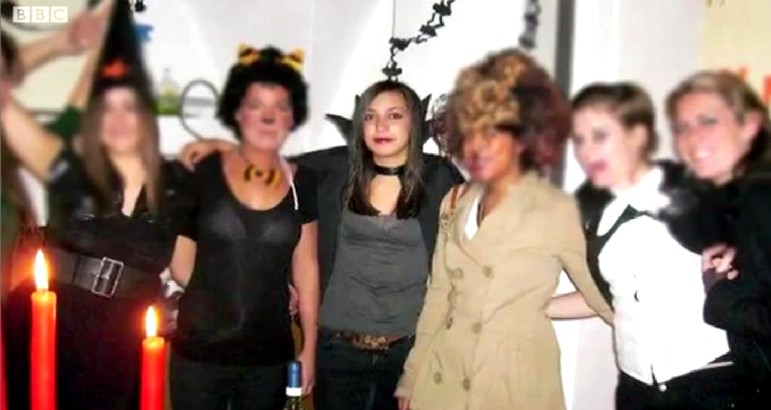
[From the BBC report: Meredith the night before the cruel, deadly attack with her Halloween friends]
This is the painstaking and obviously expensive report by Andrea Vogt and Paul Russell with interviews in London, Seattle and Perugia.
It was aired by the BBC on 17 February. Considerable time is allocated to defense lawyers and experts and the Knox family and Ann Bremner of the FOA taking their best shots at explaining how Knox could maybe have not been involved.
Still, the sheer mass of the evidence remains as the 80,000 pound elephant in the room, lacking any hint of a realistic alternative explanation. Three people committed the horrific attack, including Rudy Guede and two others.
Only Knox and Sollecito remain pointed to by dozens of evidence points as those two others. Not one single evidence point indicates anyone else was involved. The Masssei trial court got it right as the Nencini appeal court just confirmed.
We will enquire if we can embed the hour-long video. But as it may be picked up by US and other foreign media outlets, we will start by simply summarizing it soon. Assessents by those who have already seen it are welcomed.
Tuesday, February 11, 2014
The Much-Demonized Rudy Guede Is Back In The News And Increasingly Threatening
Posted by Peter Quennell
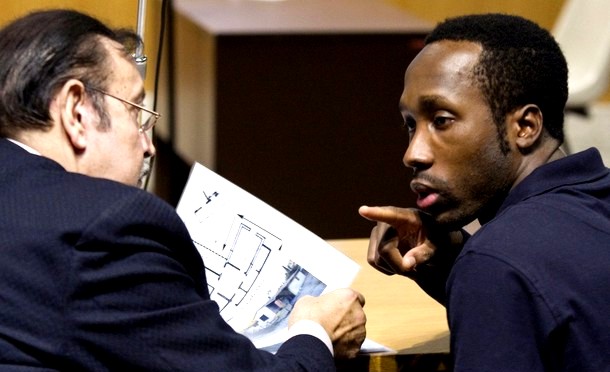
Rudy Guede has long DELIBERATELY been demonized so that the attack on Meredith can be assigned to him alone.
This description of Guede’s early days in the Ivory Coast and Perugia in the excellent Darkness Descending by Paul Russell and Graham Johnson remains the ONLY one that fully checks out. Certainly not that by the dishonest PR shill Nina Burleigh.
Guede wasn’t especially an angel, and some in Perugia were iffy about him. But he had real friends, and up north he held a real job with a real career future, until that prospect imploded and sent him haplessly back to Perugia.
Late in October 2008 Judge Micheli discounted all that Guede ever said about his role in the attack on Meredith in various conversations and statements, and sentenced Guede to 30 years.
But Judge Micheli also concluded that there was no firm evidence either that Guede acted alone or that Guede was a drifter, drug dealer, knife wielder or burglar (Micheli was very sharp with one witness who claimed Guede may - may - have broken into his house).
In 2009 through his lawyers Guede enquired of the prosecution whether he might testify at the Knox-Sollecito trial.
But the prosecutions’ hands were already tied by the indictments and they (rightly) believed they had a really strong case regardless of anything Guede could add.
At the 2009 trial the defenses pussyfooted around and never settled for a firm position on Guede. They floundered in their subdued attempts to prove that Guede or somebody else unknown was the so-called Lone Wolf.
The Lone Wolf theory is really a zombie theory with so many stakes through its heart that no court will ever take it seriously.
Guede’s steadfast fallback position before and since was that he was only in the house on the night of the attack because Meredith invited him to come in and they began love-making.
At his late-2009 first appeal and also at Sollecito’s and Knox’s 2011 appeal before Judge Hellmann, he increasingly firmly pointed the finger at Knox and Sollecito as the murderers.
Guede had been initially inclined to let sleeping dogs lie after he was mysteriously beaten up in the sex offenders wing of Viterbo prison, where prisoners are meant to be kept very safe.
But Judge Massei’s scenario of the attack on Meredith in his March 2010 Sentencing Report, with Rudy Guede as the lead instigator, really bothered him.
And in mid 2010 he became even more bothered when claims were made by a fellow prisoner the baby killer Mario Alessi that Guede confided that he really had committed the murder, along with two others. Not with Knox and Sollecito.
A very angry Rudy Guede in turn wrote a letter denying this which very rapidly went public.
In 2011 there was a tense confrontation in the Hellmann court (which several times descended into chaos) when this letter, in which by now Guede firmly accuses Knox and Sollecito, was read out for him.
Guede stuck to this position on the stand, and he was not required to face full cross-examination by the shrill, frustrated defenses because he was already convicted and no longer the one on trial.
Seemingly fed up with all the dirty tricks against him and the now-incessant Knox and Sollecito mantras in the media that Guede had acted alone, he has come out with another letter.
Italy’s AGI News Service has posted this letter to an unidentified recipient, along with this report.
(AGI) Perugia, February 11 “Against me are being repeated false imaginated reconstructions of the crime for the sole purpose of wanting to denigrate my figure and person, systematically and in a negative way, in the public eye and not just in Italy.”
He apparently also posted what he wrote in his own hand on the Facebook page “Legal processes and their surroundings”...
The letter is on a sheet of notebook paper handwritten and signed by Guede.
“To my regret I am again forced to take a pen and paper and write for the sake of the truth.. to all those thousands of people who still believe in justice.”
“They can not access all the pleadings and components of this sad and extremely complex legal case which was dramatically painful for those who lived it . My sentence and judicial reasoning have been for too long subject to a continuous and willful manipulation and alteration of the data of the proceedings.”
“Against me are made continuous false and imaginary reconstructions for the sole purpose of wanting to denigrate my figure and person, systematically and in a negative way in the public eye and not just the Italian.”
“In the final judgment, as far as I’m concerned about these false and imaginative reconstructions, is that I was acquitted of theft and simulation of crime, a fact that I never hear mentioned in the various journalistic reconstructions.”
“I also want to point out I do not accept in any way to be passed off and continually held up as a drifter, a thief, a homeless man, seeing my person and my dignity offended continually, denigrated and stereotyped by facts and things that do not realte to me… when I had a beautiful family and precious squeaky clean and friendly relations in Perugia.”
Fast-forward to today, where reports say that Guede is getting close to day-release for study purposes and may only be months away from making more evidence against Sollecito and Knox public.
Our posting lawyer TomM has looked at the issue of Guede being allowed out to study, and finds it regular and humane in this assessment.
I respect the Italian system of criminal justice. Just as I recognize that the Italian courts have much better information than anyone posting on the internet relating to the culpability of the defendants in this case, I also think that the people who oversee Guede’s stay in prison are better informed as to his fitness to be reintegrated into society. That he would be allowed out during work days to become better educated, returning to his prison cell at the end of the day seems to me a more enlightened approach than what we do here.
We used to have training programs in prisons. I don’t know that they were “cushy”, but they did work, so that when these convicts were released they were equipped with a marketable skill and rarely re-offended. But, the public thinks these were too cushy, so more Draconian circumstances and longer sentences are now the norm. It used to be people were sent to prison as punishment, now they are sent for punishment.
Sometimes when a prisoner who has spent his or her entire adult life in prison completes the sentence imposed, they have to be physically dragged from their cells, so ill-prepared are they for anything other than doing time. With no skills, social or job-related, they re-offend—surprise, surprise. Sometimes re-offense is for the purpose of being returned a world that, for all its dangers is, to them, relative safety.
While it is certainly true that prison doesn’t have much impact on sociopaths, the one thing they are attached to is money. Taking away their money does impact their behavior, so there is an alternative to killing them.
